Question 1
Refer to the exhibit. Router RIP is attempting to establish BGP neighbor relationships with routers RT1 and RT3. On the basis of the information that is presented in the exhibit, which two statements are true? (Choose two)
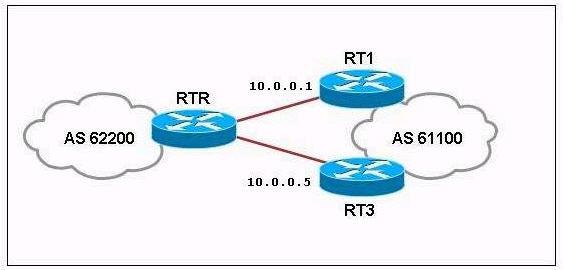
 A – RTR has a BGP password set but neighbor 10.0.0.1 does not
A – RTR has a BGP password set but neighbor 10.0.0.1 does not
B – RTR has a BGP password set but neighbor 10.0.0.5 does not
C – RTR has a BGP password set but neighbor 10.0.0.1 has an incorrect password set
D – RTR has a BGP password set but neighbor 10.0.0.5 has an incorrect password set
E – Neighbor 10.0.0.1 has a BGP password set but RTR does not
F – Neighbor 10.0.0.5 has a BGP password set but RTR does not
Answer: A D
Explanation:
You can configure MD5 authentication between two BGP peers, MD5 authentication must be configured with the same password on both BGP peers; otherwise, the connection between them will not be made. If a router has a password configured for a peer, but the other peer does not, a message “No MD5 digest from…” will appear on the console while the routers attempt to establish a Multicast Source Discovery Protocol (MSDP) session between them. Therefore A is correct because RT1 (with an ip address of 10.0.0.1) is not configured with a password.
Similarly, if the two routers have different passwords configured, a message “Invalid MD5 digest from…” will appear on the screen.
Question 2
Refer to the exhibit diagram and configuration. RTB is summarizing its networks from AS 64100 with the aggregate-address command. However, the show ip route command on RTA reveals the RTB individual networks as well as its summary route. Which option would ensure that only the summary route would appear in the routing table of RTA?
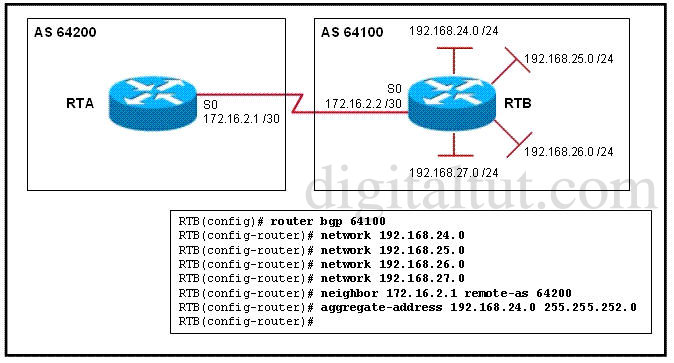 A – Delete the four network statements and leave only the aggregate-address statement in the BGP configuration
A – Delete the four network statements and leave only the aggregate-address statement in the BGP configuration
B – Add the keyword summary-only to the aggregate-address command
C – Add a static route with a prefix of 192.168.24.0 255.255.252.0 pointing to the null interface
D – Create a route map permitting only the summary address
Answer: B
Explanation
When the aggregate-address command is used within BGP routing, the aggregated address is advertised, along with the more specific routes. The exception to this rule is through the use of the summary-only command. The “summary-only” keyword suppresses the more specific routes and announces only the summarized route.
Question 3
Refer to the exhibit The neighbor 10.1.1.1 weight 200 BGP configuration command has been configured on router A. What will be the result of this configuration?
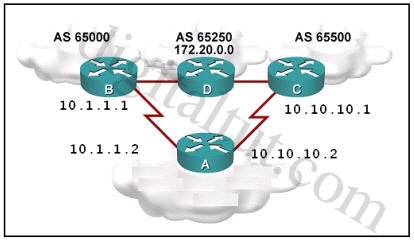 A – Router A will prefer the path through router B for network 172.20.0.0
A – Router A will prefer the path through router B for network 172.20.0.0
B – Router A will prefer the path through router C for network 172.20.0.0
C – Packets from router D will prefer the path through router B for networks advertised by router A
D – Packets from router D will prefer the path through router C for networks advertised by router A
Answer: A
Explanation
The weight attribute is a special Cisco attribute that is used in the path selection process when there is more than one route to the same destination. The higher the weight value, the better the path. The default weight is 0. Therefore, by configuring weight 200 to the neighbor 10.1.1.1, router A will prefer the path through router B for network 172.20.0.0 then the path through router C.
The weight attribute is local to the router and not propagated to other routers. In this case the weight is local to router A so it has no effect on the decision of transferring packets from router D.
Question 4
Based on the show ip bgp summary output. which two statements are true? (Choose two)
 A – The BGP session to the 10.1.1.1 neighbor is established
A – The BGP session to the 10.1.1.1 neighbor is established
B – The BGP session to the 10.2.2.2 neighbor is established
C – The BGP session to the 10.3.3.3 neighbor is established
D – The router is attempting to establish a BGP peering session with the 10.1.1.1 neighbor
E – The BGP session to the 10.3.3.3 neighbor is established, but the router has not received any BGP routing updates from the 10.3.3.3 neighbor
F – The router is attempting to establish a BGP peering session with the 10.2.2.2 neighbor
Answer: A F
Explanation
The main point of this question is the “State/PfxRcd” column, which shows the BGP states. Below is the list of BGP states in order, from startup to peering:
1 – Idle: the initial state of a BGP connection. In this state, the BGP speaker is waiting for a BGP start event, generally either the establishment of a TCP connection or the re-establishment of a previous connection. Once the connection is established, BGP moves to the next state.
2 – Connect: In this state, BGP is waiting for the TCP connection to be formed. If the TCP connection completes, BGP will move to the OpenSent stage; if the connection cannot complete, BGP goes to Active
3 – Active: In the Active state, the BGP speaker is attempting to initiate a TCP session with the BGP speaker it wants to peer with. If this can be done, the BGP state goes to OpenSent state.
4 – OpenSent: the BGP speaker is waiting to receive an OPEN message from the remote BGP speaker
5 – OpenConfirm: Once the BGP speaker receives the OPEN message and no error is detected, the BGP speaker sends a KEEPALIVE message to the remote BGP speaker
6 – Established: All of the neighbor negotiations are complete. You will see a number (2 in this case), which tells us the number of prefixes the router has received from a neighbor or peer group.
Question 5
Which command displays the IBGP and EBGP neighbors that are configured?
A – show ip bgp
B – show ip bgp paths
C – show ip bgp peers
D – show ip bgp summary
Answer: D
Explanation
The picture below shows the output of the show ip bgp summary
 Notice that the “show ip bgp” command to display BGP topology database. Below is the output of the “show ip bgp” command:
Notice that the “show ip bgp” command to display BGP topology database. Below is the output of the “show ip bgp” command:
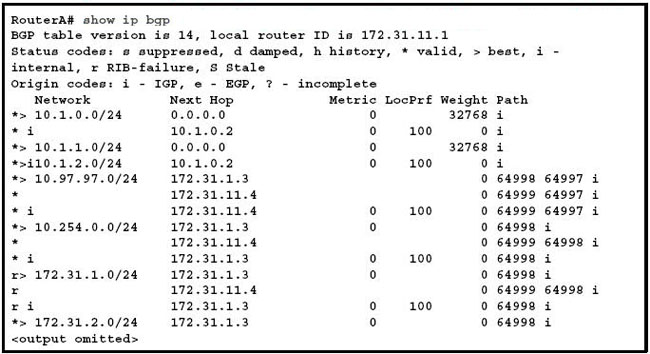
Question 6
BGP contains two paths to a destination. Assuming both routes were originated locally and have an equal weight. what will be the next determining factor in choosing the best path?
A – lowest MED
B – highest local preference
C – lowest neighbor IP address
D – lowest origin code
E – shortest AS-path
Answer: B
Explanation
Memorizing the BGP decision process steps is very useful and you should remember them. The table below lists the complete path selection process:
1. Weight (Bigger is better)
2. Local preference (Bigger is better)
3. Self originated (Locally injected is better than iBGP/eBGP learned)
4. AS-Path (Smaller is better)
5. Origin (Prefer ORIGIN code I over E, and E over ?)
6. MED (Smaller is better)
7. External (Prefer eBGP over iBGP)
8. IGP cost (Smaller is better)
9. EBGP Peering (Older is better)
10. RID (Lower is better)
Question 7
Which BGP path attribute is Cisco proprietary?
A. weight
B. MED
C. local preference
D. origin
E. next-hop
F. AS-path
Answer: A
Explanation
The weight attribute is a Cisco proprietary technology. This attribute is local to a router and is not advertised to neighboring routers. If the router learns about more than one route to the same destination, the route with the highest weight will be preferred and will be installed in the routing table. By default, the value of weight is 0 and the range is from 0 to 65535.
The route with the highest weight will be installed in the IP routing table.
Question 8
Which attribute must exist in the BGP update packet?
A. LOCAL_PREF
B. AGGREGATOR
C. AS_Path
D. Weight
Answer: C
Explanation
Origin, AS_Path, Next_Hop are well-known mandatory BGP attributes that all BGP Updates must include.
Note:
There are 4 BGP attribute types:
+ Well-known Mandatory: recognized by all implementations of BGP and must appear in a BGP update message. If missing, a notification error will be generated.
+ Well-Known Discretionary: recognized by all implementations of BGP but may not be sent in the BGP update message (include LOCAL_PREF, ATOMIC_AGGREGATOR).
+ Optional Transitive: may or may not be recognized by all BGP implementations. Because the attribute is transitive, BGP accepts and advertises the attribute even if it is not recognized (include Community attribte).
+ Optional Nontransitive: may or may not be recognized by all BGP implementations. Whether or not the receiving BGP router recognizes the attribute, it is nontransitive and is not passed along to other BGP peers (include MED).
Question 9
When the BGP path selection process is being performed on a Cisco router, which BGP attribute is used first when determining the best path?
A. local preference
B. MED
C. weight
D. origin
E. next-hop
F. AS-path
Answer: C
Explanation
Weight is the first attribute BGP uses in the route selection process. Route with a higher weight is preferred when multiple routes exist to the same destination.
Question 10
Which BGP attribute will not be advertised in routing updates to its neighboring routers?
A. weight
B. local preference
C. origin
D. AS_path
E. next hop
Answer: A
Question 11
Study the configuration presented in the exhibit carefully. What is the objective of the route map named test?
A. marks all prefixes received from the 10.1.1.1 neighbor with a MED of 200
B. marks the 10.0.0.0/8 prefix received from the 10.1.1.1 neighbor with a MED of 200
C. marks the 10.0.0.0/8 prefix advertised to the 10.1.1.1 neighbor with a MED of 200
D. marks all prefixes advertised to the 10.1.1.1 neighbor with a MED of 200
Answer: C
Explanation
From the command “neighbor 10.1.1.1 route-map test out” we learn the “test” route map is applied on the outbound direction to the neighbor 10.1.1.1. In the “test” route map, we see 3 statements:
“route-map test permit 10
match ip address 1
set metric 200″
They mean “if the access list 1 is matched, set the Multi Exit Discriminator (MED) of that route to 200″.
Question 12
What technique should be used on BGP edge routers to prevent a multi-homed autonomous system from becoming a transit system?
A. Advertise with a high MED value all networks that are discovered via external BGP.
B. Remove the AS-Path information on all routes in the BGP table prior to advertising externally.
C. Only advertise networks externally if they have been discovered via internal BGP.
D. Use an outgoing distribution list to filter all networks not originating from inside the autonomous system.
E. Set the no-export community attribute on all networks that are advertised externally.
F. Set the origin code to incomplete for all networks that are discovered via external BGP.
Answer: D
Explanation
A transit AS is an AS that routes traffic from one external AS to another external AS. Let’s see an example below:
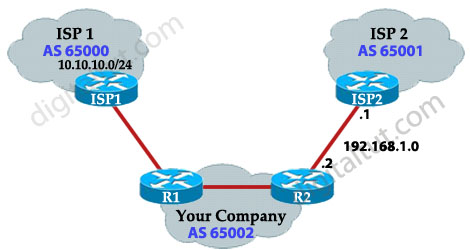 Suppose your company has 2 internet links to 2 different ISPs. If one connection to the ISP goes down, your traffic can be sent through the other ISP. It is a good way to make sure your company can access the internet any time. But if your routers are not configured carefully, your company AS may become a transit AS. For example, AS 65002 learned the route 10.10.10.0/24 from ISP1. If R2 advertises that route to ISP2 then ISP2 may use it to send traffic to that network -> your company becomes a transit AS.
Suppose your company has 2 internet links to 2 different ISPs. If one connection to the ISP goes down, your traffic can be sent through the other ISP. It is a good way to make sure your company can access the internet any time. But if your routers are not configured carefully, your company AS may become a transit AS. For example, AS 65002 learned the route 10.10.10.0/24 from ISP1. If R2 advertises that route to ISP2 then ISP2 may use it to send traffic to that network -> your company becomes a transit AS.
There are two popular ways to prevent a multi-homed autonomous system from becoming a transit system:
+ Use a distribute-list or filter-list to filter all networks not originating from inside the autonomous system.
+ Use the no-export community attribute on all networks not originating from inside the autonomous system.
Answer E seems to be correct but in fact it is not because “all networks that are advertised externally” include networks originating from inside and outside our AS. We should only filter networks originating from outside our AS. In some cases, the routers in our company may advertise some internal networks (for remote access, for example).
Question 13
Refer to the exhibit. By default, when RTB passes BGP advertisements from RTA about network 192.168.2.0 to RTC, what address will be listed as the next-hop address?
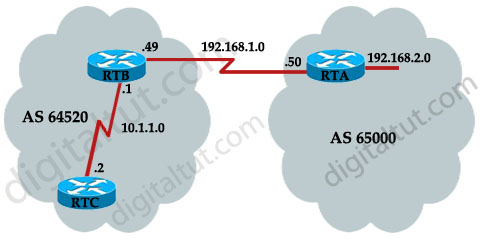 A. 10.1.1.1
A. 10.1.1.1
B. 10.1.1.2
C. 192.168.1.49
D. 192.168.1.50
Answer: D
Explanation
This is a rule for BGP advertisement:
“For EBGP, the next hop is always the IP address of the neighbor specified in the neighbor command. For IBGP, the protocol states that the next hop advertised by EBGP should be carried into IBGP“.
In this case, when RTA (in AS 65000, which is an EBGP for RTB) advertises a route to RTB, it specifies its interface (192.168.1.50) as the next-hop. But when RTB passes this advertisement to RTC, it specifies RTA interface (also 192.168.1.50) as the next-hop (IBGP). This can cause some routing failures because if RTC does not know a way to reach RTA interface via IGP (OSPF, EIGRP…), it will drop that packet. To fix this problem, add the “neighbor 10.1.1.2 next-hop-self” command under BGP mode in RTB.
Question 14
What are the two reasons for the appearance of 0.0.0.0 as the next hop for a network in the show ip bgp command output? (Choose two)
A. The network was originated via redistribution of an interior gateway protocol into BGP.
B. The network was defined by a static route.
C. The network was originated via a network or aggregate command.
D. The network was learned via EBGP.
E. The network was learned via IBGP.
Answer: A C
Question 15
Which BGP attribute is used by BGP to prevent routing loops?
A. AS-path
B. next-hop
C. MED
D. weight
E. local preference
F. origin
Answer: A
Explanation
The AS-PATH attribute is used to prevent BGP routing loops. When receiving an BGP advertisement, the router checks the AS-PATH attribute, if it see it’s own AS number in the AS-Path then it is a routing loop so the router will not install this route in its BGP table.
Question 16
Refer to the exhibit. It is desired to set up a BGP neighbor relationship between routers R1 and R4. BGP packets between them could travel through R2 or R3. What is the simplest configuration that will allow for failover?
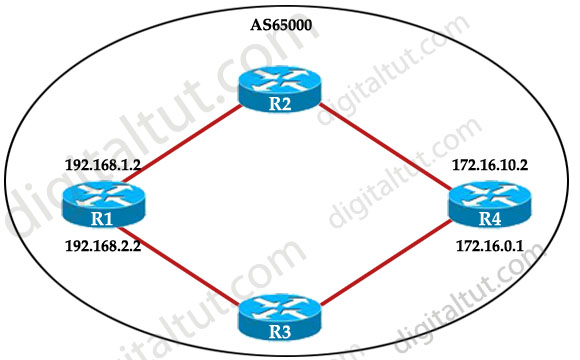 A. Configure BGP neighbor relationships between all interfaces on R1 and R4.
A. Configure BGP neighbor relationships between all interfaces on R1 and R4.
B. Install a direct connection between R1 and R4.
C. Configure loopback interfaces on R1 and R4 to provide the update source address for BGP packets.
D. Configure only one neighbor relationship between R1′s 192.168.1.2 interface and R4′s 172.16.10.2 interface.
Answer: C
Explanation
Assume R4 only uses this configuration:
R4(config)#router bgp 65000
R4(config-router)#neighbor 192.168.1.2 remote-as 65000
Then if R1 sends BGP packets to R4 via R3, the source IP address of the packets is 192.168.2.2. But R4 does not recognize this IP address because 192.168.2.2 is not configured in the “neighbor” command of R4. Therefore the IBGP session between R1 & R4 is not established -> these packets will be dropped.
The simplest configuration to allow R1 and R4 communicate via both R2 & R3 is to use a loopback interface address rather than a physical interface address as the source IP address for all BGP packets. To do this, use the command:
R4(config-router)#neighbor 1.1.1.1 update-source loopback0
(In which 1.1.1.1 is the loopback interface of R1). In practical, we should establish neighborship with the loopback interface rather than the physical interface because if the physical interface goes down, the neighborship would be lost while a loopback interface never goes down.
Also, when configuring “1.1.1.1″ as the neighbor, you must configure on R1 the “neighbor 4.4.4.4 update-source loopback0” command so that the source IP address of packets sent from R1 (loopback0 – 1.1.1.1) will be matched with the neighbor command configured on R4.
Question 17
Refer to the exhibit. Network 10.0.0.0/8 is being advertised to autonomous system 65550 via both external links. Which statement about the preferred path to the 10.0.0.0/8 network is true?
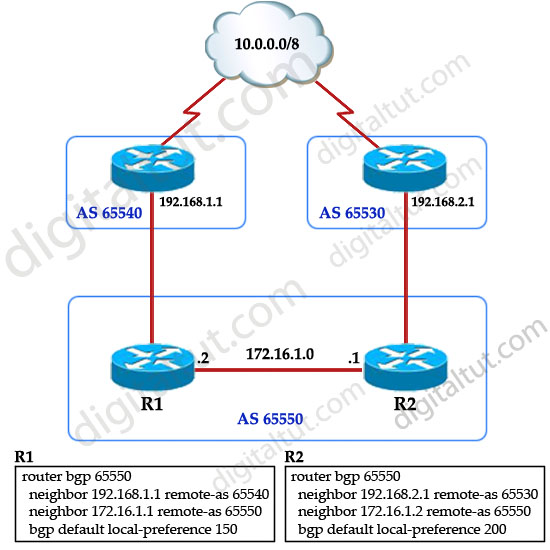 A. Router R1 will be preferred because its neighbor has the higher autonomous system number.
A. Router R1 will be preferred because its neighbor has the higher autonomous system number.
B. Router R1 will be preferred because it has the lower neighbor IP address.
C. Router R1 will be preferred because it has a lower local preference.
D. Router R2 will be preferred because its neighbor has a lower autonomous system number.
E. Router R2 will be preferred because it has the higher neighbor IP address.
F. Router R2 will be preferred because it has a higher local preference.
Answer: F
Explanation
Local preference is an indication to the AS about which path has preference to exit the AS in order to reach a certain network. A path with a higher local preference is preferred more. The default value for local preference is 100.
Unlike the weight attribute, which is only relevant to the local router, local preference is an attribute that routers exchange in the same AS. The local preference is set with the “bgp default local-preference value” command.
In this case, both R1 & R2 learn about the network 10.0.0.0/8 but R2 has higher local-preference so R2 will be chosen as the preferred exit point from AS 65550.
Question 18
During BGP configuration on a router that has peered with other BGP speakers, the BGP command aggregate-address 172.32.0.0 255.255.252.0 is issued. However, the peers do not receive this aggregate network in BGP advertisements. Also, the router does not have this aggregate network in its BGP table. Which option indicates a possible reason this command did not cause the router to advertise the aggregate network to its peers?
A. Interface NULL 0 is likely shutdown.
B. The BGP command no synchronization is missing.
C. The BGP command no auto-summary is missing.
D. Subnets of 172.32.0.0/22 do not exist in the BGP table.
E. The IGP running on this router does not have network 172.32.0.0/22 installed.
F. The next hop IP address must be a loopback address.
Answer: D
Explanation
A rule of aggregation is “Aggregation applies only to routes that exist in the BGP routing table. An aggregated route is forwarded if at least one more specific route of the aggregation exists in the BGP routing table.
Question 19
Which two methods advertise internal networks to external ISPs via BGP? (Choose two)
A. using aggregate routes
B. disabling synchronization
C. forcing the next-hop address
D. defining routes via the network statement
Answer: A D
Question 20
Which BGP command provides the router ID, local preference, next hop, and BGP path in its output?
A. show ip route bgp
B. show ip bgp
C. show ip bgp neighbors
D. show ip bgp summary
Answer: B
Explanation
The “show ip bgp” command is used to display entries in the BGP routing table. An example of the “show ip bgp” output is shown below:

In the output you can see the router ID, local preference, next hop, and BGP path.
Question 21
Which option is true regarding the synchronization rule?
A. Do not use or internally advertise a route until the route is learned from a source other than BGP.
B. Do not use or advertise a route until the route is learned from a BGP peer.
C. Do not use or advertise routes marked PARTIAL.
D. Wait until a CONFIRM message is received before using routes from BGP neighbors.
Answer: A
Explanation
The complete synchronization rule is “A BGP router should not use, or advertise to an external neighbor, a route learned by IBGP, unless that route is local or is learned from the IGP.”
With the default of synchronization disabled, BGP can use and advertise to external BGP neighbors routes learned from an IBGP neighbor that are not present in the local routing table
The “synchronization” here means “synchronization between iBGP with its IGP (such as OSPF, EIGRP…)
You can disable synchronization if one of the following conditions is true:
Your AS does not pass traffic from one AS to another AS.
All the transit routers in your AS run BGP.
Note: BGP synchronization is disabled by default in Cisco IOS Software Release 12.2(8)T and later.
Question 22
Refer to the exhibit. Router RT-1 and router RT-2 both advertise network 131.25.0.0/16 to router RT-3 via internal BGP. What is the reason that router RT-3 chose router RT-1 as its best path to network 131.25.0.0/16.
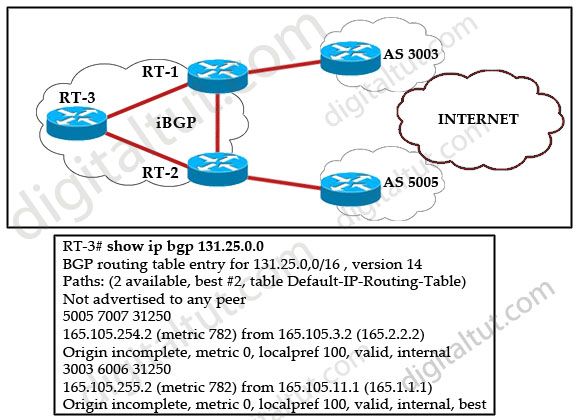 A. It advertises the best AS-path.
A. It advertises the best AS-path.
B. It advertises the best origin code.
C. It advertises the best MED.
D. It advertises the best local preference.
E. It has a better router ID.
F. It advertises a lower autonomous system.
Answer: E
Explanation
Recall the route selection decision process in BGP:
Consider only (synchronized) routes with no AS loops and a valid next hop, and then:
Question 23
Refer to the exhibit. Router RT-1 chooses one path to network 198.133.219.0/24. Indicate the reason Router RT-1 chooses this “best” path.
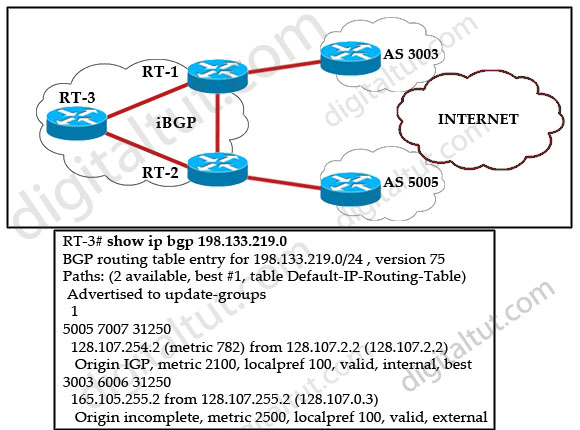
A. In making its decision about the best path, RT-1 gives precedence to the origin code.
B. In making its decision about the best path, RT-1 gives precedence to the BGP MED values.
C. IP address 128.107.2.2 is lower than 128.107.255.2.
D. In making its decision about the best path, RT-1 prefers the IGP metrics.
E. RT-1 prefers internal BGP routes.
F. IP address 128.107.254.2 is lower than 128.107.255.2.
Answer: A
Explanation
As explained in question 3, the IGP is preferred over incomplete.
Question 24
The Border Gateway Protocol (BGP) is the core routing protocol of the Internet. Refer to the exhibit. Routers A and B are running BGP but the session is active. What command needs to be added to establish the BGP session?
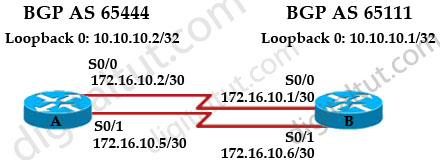
A. ip route 10.10.10.1 255.255.255.255 s0/0
ip route 10.10.10.1 255.255.255.255 s0/ 1
B. no synchronization
C. network 10.10.10.0
D. neighbor 10.10.10.1 next-hop-self
Answer: A
Explanation
In this case we want to achieve load balancing so the loopback interface must be used to establish neighborship.
If we check the routing table of router A, we will see that there is no entry for the remote network 1.1.1.1/32 -> router A does not know how to reach the loopback interface on router B -> a TCP session can’t be established to router B. Therefore we need to tell router A a way to reach router B.
Question 25
Refer to the exhibit. Autonomous systems 200 and 300 have EBGP sessions established with their directly connected routers in autonomous system 100. IGP has been configured on all routers in autonomous system 100 and they successfully exchange routing updates. Traffic originated in autonomous system 200 cannot reach the destination autonomous system 300. What configuration should be done on the routers in autonomous system 100 in order for the traffic coming from autonomous system 200 to be forwarded to autonomous system 300?
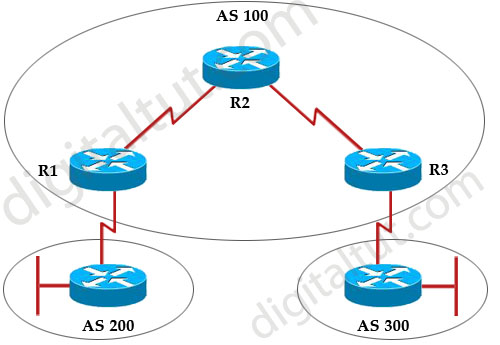 A. IBGP session must be established between routers R1 and R3, and the synchronization must be turned on.
A. IBGP session must be established between routers R1 and R3, and the synchronization must be turned on.
B. IBGP session must be established between routers R1 and R3, and the synchronization must be turned off.
C. IBGP session must be established between routers R1 R2 and R2 R3. and the synchronization must be turned on.
D. IBGP session must be established between routers R1 R2 and R2 R3, and the synchronization must be turned off.
E. IBGP speakers within autonomous 100 must be fully meshed, and the synchronization must be turned on.
F. IBGP speakers within autonomous 100 must be fully meshed, and the synchronization must be turned off.
Answer: F
Explanation
The synchronization rule states that if an AS provides transit service to another AS, BGP should not advertise a route until all of the routers within the AS have learned about the route via an IGP. To understand why this rule exists, let’s take an example if this rule is not there.
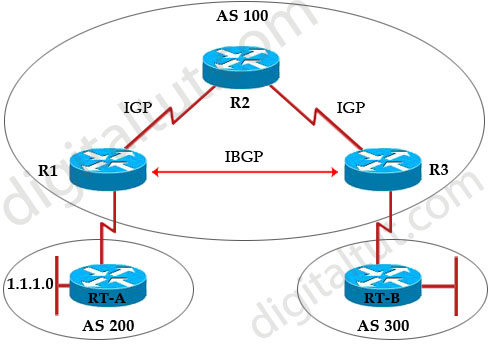 Suppose Rt-A wants RT-B to access its local LAN 1.1.1.0, so it advertises this network through R1. R1 and R3 are running IBGP so R1 sends this update to R3 through R2 (using the next-hop-self to use its own interface’s IP address). In turn, R3 announces to RT-B that it can reach 1.1.1.0 via R3.
Suppose Rt-A wants RT-B to access its local LAN 1.1.1.0, so it advertises this network through R1. R1 and R3 are running IBGP so R1 sends this update to R3 through R2 (using the next-hop-self to use its own interface’s IP address). In turn, R3 announces to RT-B that it can reach 1.1.1.0 via R3.
Now Rt-B really wants to send traffic to 1.1.1.0 so it will send to R3. R3 does a look up and sees that the network can be reachable via R1. It then does a lookup for R1′s IP address and sees that it is reachable via R2 -> so it forwards packets to R2. But R2, running IGP (like OSPF), does not find an entry for 1.1.1.0 so R2 drops all the packets for that network – a black-hole is created!
That is why the BGP synchronization rule is born. With this rule, when R3 receives an advertisement for 1.1.1.0 from R1, it adds that route to its BGP table and before sending advertisement to RT-B, it first checks its IGP routing table to see whether an entry exists for that route. In this example, R3′s IGP routing table does not know how to reach 1.1.1.0 so R3 will not advertise this network to RT-B. This route is only advertised to RT-B when IGP makes an entry in the routing table for 1.1.1.0.
Well, now you understand the importance of BGP Synchronization rule but now I wish to explain why this rule causes trouble in fully-meshed IBGP!
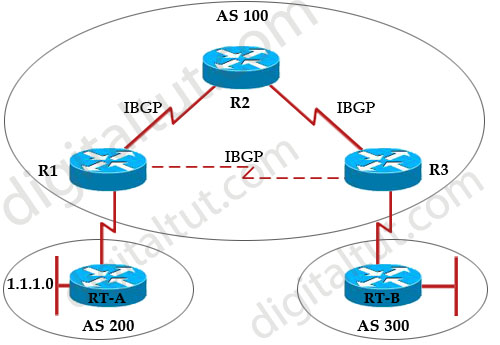 Synchronization prevents fully-meshed IBGP from working properly. Because no IGP is running so R3 cannot advertise any route to RT-B even if no black-hole exists in this topology.
Synchronization prevents fully-meshed IBGP from working properly. Because no IGP is running so R3 cannot advertise any route to RT-B even if no black-hole exists in this topology.
Note: A “fully-meshed” can be a physical fully-meshed topology or a topology where all routers in the same AS established IBGP connections with each other (although they do not need to be directly connected). So in the topology above, the connection between R1 & R3 is represented by a dashed line, which means it can be physically connected or not (but an IBGP connection must be established on both routers).
Therefore if all routers in AS 100 is fully-meshed, the synchronization rule must be turned off -> F is correct.
Question 26
Which one of the following statements about BGP is FALSE?
A. BGP uses TCP port 179.
B. BGP ensures reliability of updates by using the reliable transport services of TCP.
C. The network command with the mask option never installs a prefix into the BGP table unless there is a matching prefix exists in the IP route table.
D. A TCP connection is required before exchanging updates.
E. BGP uses notification and the update messages to establish and maintain the BGP neighbor relationship.
Answer: E
Explanation
An underlying connection between two BGP speakers is established before any routing information is exchanged. This connection takes place on TCP port 179.
Unlike other routing protocols, the router must be manually configured with the neighbor information on both sides of the connection -> E is correct (which is FALSE in this question)
Question 27
Which BGP option is required when load sharing over multiple equal-bandwidth parallel links from a single CE router to a single ISP router over eBGP?
A. eBGP Multipath
B. eBGP Multihop
C. BGP Synchronization
D. Public AS numbers
Answer: B
Explanation
The eBGP multihop allows a neighbor connection between two external peers that do not have direct connection. The multihop is only for eBGP and not for iBGP. For example, in the topology below router A wants to establish neighbor relationship with the loopback0 of router B (to allow load balancing), which does not have direct connection so it must use “ebgp-multihop”

For your reference, the full configurations of both router A & B are shown below:
Note: If router B wants to establish neighbor relationship with the directly connected interface of router A, it only needs these commands:
But notice the traffic from router B would be sent to 172.16.10.2 interface only and load balancing would not take place.
Question 28
Which statement is true about IBGP routers?
A. They must be fully meshed.
B. They can be in a different AS.
C. They must be directly connected,
D. They do not need to be directly connected.
Answer: D
Question 29
Refer to the exhibit. On the basis of the configuration that is provided, how would the BGP updates that come from router R1 be replicated inside autonomous system 65200?
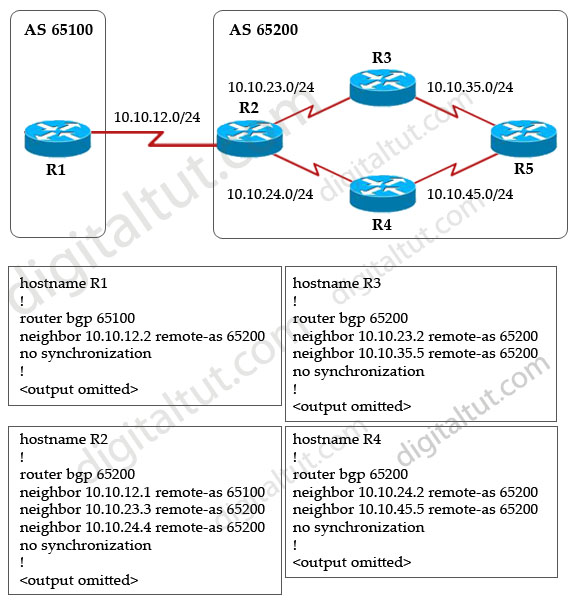 A. All BGP updates that are received on router R2 will be sent to routers R3 and R4. Routers R3 and R4 will then forward those BGP updates to router R5.
A. All BGP updates that are received on router R2 will be sent to routers R3 and R4. Routers R3 and R4 will then forward those BGP updates to router R5.
B. All BGP updates that are received on router R2 will not be sent to routers R3 and R4.
C. All BGP updates that are received on router R2 will be sent directly to router R5.
D. None of the BGP updates that are received on router R2 will ever be received by router R5.
Answer: D
Explanation
All BGP updates that are received on router R2 will be sent to routers R3 and R4 but R3 & R4 will not forward those BGP updates to R5. This is called the BGP split-horizon rule (which states that a route learned from one IBGP neighbor will not be advertised to another IBGP neighbor) -> A is not correct.
The BGP updates received on router R2 will be sent to R3 and R4 without violating the BGP split-horizon rule because R2 receives updates from an EBGP (R1), not IBGP -> B is not correct.
From the configuration of R2, we learn that R2 did not establish neighbor relationship with R5 so they are not neighbors -> no BGP updates will be sent from R2 to R5 -> C is not correct.
The BGP split-horizon rule prevents updates received on R2 from being sent to R5 -> D is correct.
Question 30
The 192.168.0.0 network is not being propagated throughout the network. Observe the BGP configuration commands from the advertising router. What is the reason the 192.168.0.0 route is not being advertised?
A. The network 192.168.0.0 statement is missing mask 255.255.0.0
B. The network 192.168.0.0 statement is missing mask 0.0.255.255.
C. The network 10.0.0.0 statement is missing mask 255.0.0.0.
D. The network 10.0.0.0 statement is missing mask [IMG]resource://skype_ff_extension-at-jetpack/skype_ff_extension/data/call_skype_logo.png[/IMG]0.255.255.255.
E. The auto-summary configuration is missing.
Answer: A
Explanation
The “network” statement in other routing protocols (EIGRP, OSPF, RIP…) is used to enable routing protocol on the interfaces within that “network” statement. But in BGP, the function of a network statement is to tell the router to search the IP routing table for a particular network, and if that network is found, originate it into the BGP database. But notice that you must have an exact match in the IP routing table to appear the network in the BGP routing table (in this case we don’t see the auto-summary command so we suppose it is disabled in this case). For example:
+ network 10.10.10.0/8 will appear in BGP if network 10.10.10.0/8 appears in the IP routing table.
+ network 10.10.10.0/24 will appear in BGP if network 10.10.10.0/24 appears in the IP routing table.
Therefore, in this question the static route “ip route 192.168.0.0 255.255.0.0 null0″ was used to put a route to 192.168.0.0/16 into the routing table (although it points to Null0 but this command really makes that route appears in the routing table). But the “network 192.168.0.0″ statement tells the router to lookup network 192.168.0.0/24 (if the network statement under BGP-mode does not specify a subnet mask, the default subnet mask of that class will be used). The router only finds network 192.168.0.0/16 -> The network 192.168.0.0 is not being propagated throughout the network because of the mismatch of the subnet mask -> A is correct.
Just for your information, in fact we have to suppose there is no entry of the network 192.168.0.0/24 exist in the routing table except the static route “ip route 192.168.0.0 255.255.0.0 null0″. If such an entry exists (for example, a directly connected entry like “C 192.168.0.0/24 is directly connected”) then the router still advertises it with the “network 192.168.0.0″ (without mask 255.255.0.0) command.
Question 31
Which two conditions can cause BGP neighbor establishment to fail? (Choose two)
A. There is an access list blocking all TCP traffic between the two BGP neighbors.
B. The IBGP neighbor is not directly connected.
C. BGP synchronization is enabled in a transit autonomous system with fully-meshed IBGP neighbors.
D. The BGP update interval is different between the two BGP neighbors.
E. The BGP neighbor is referencing an incorrect autonomous system number in its neighbor statement.
Answer: A E
Explanation
An underlying connection between two BGP speakers must be established before any routing information is exchanged. This connection takes place on TCP port 179 so if an access list blocks all TCP traffic between the two BGP neighbors, BGP neighbor relationship can not be established -> A is correct.
The IBGP neighbors don’t need to be directly connected -> B is not correct.
BGP synchronization only prevents routes sent to other EBGP neighbors before that route exists in the routing table. It doesn’t prevent BGP neighbor relationship -> C is not correct.
After the first initial exchange (which exchanges routes and synchronize their tables), a BGP speaker will only send further updates upon a change in the network topology -> BGP does not have a fixed update interval -> D is not correct.
BGP neighbor relationship is established when both ends (routers) are manually configured with the “neighborneighbor-IP remote-as neighbor-AS” command on both sides of the connection. If the neighbor-AS is wrong, the neighbor relationship can not be established -> E is correct.
Question 32
Which statement is true about EBGP?
A. An internal routing protocol can be used to reach an EBGP neighbor.
B. The next hop does not change when BGP updates are exchanged between EBGP neighbors.
C. A static route can be used to form an adjacency between neighbors.
D. EBGP requires a full mesh.
Answer: C
Explanation
When two EBGP neighbors want to establish neighbor relationship without using the directly connected interfaces (for example, use loopback interface), they must tell each other how to reach their interfaces. A static route is the most simple way to do this, especially when they are in different ASs.
Question 33
Why should iBGP sessions be fully meshed within a Transit AS?
A. BGP requires redundant TCP sessions between iBGP peers.
B. A full mesh allows for optimal routing within the Transit AS.
C. Routes learned via iBGP are never propagated to other eBGP peers.
D. Routes learned via iBGP are never propagated to other iBGP peers.
E. Routes learned via eBGP are never propagated to other iBGP peers.
Answer: D
Explanation
BGP split-horizon rule states that a route learned from one IBGP neighbor will not be advertised to another IBGP neighbor so IBGP sessions should be fully meshed. For example in the topology below, routes learned from R1 about AS 200 will be advertised to R2. For R2, the route learned from R1 is a route learned from one IBGP neighbor so R2 will not advertise this route to R3 and AS 100 can never be a transit AS -> IBGP sessions should be fully meshed within a transit AS -> D is correct.

Question 34
Which BGP feature should be used to avoid high memory utilization on a router?
A. soft-reconfiguration
B. route refresh
C. BGP communities
D. full-mesh BGP peering
Answer: B
Explanation
BGP routers have enormous routing tables so it uses much memory to proceed these routes. When a BGP policy is changed, the BGP session needs to be reset for the policy to take effect. But the resetting results in route churn and route flapping. There are two ways to clear a BGP session without resetting the TCP session between them (this is often called “soft reset”):
Soft-reconfiguration: stores all received (inbound) routing policy updates without modification in a table so that when a new filter is applied, the router will use this table to calculate the changes without resetting the TCP session between the two BGP peers . This is a memory-intensive (high memory utilization) method and is not recommended.
Route-refresh: allows a BGP router to request a remote peer resend its BGP Adj-RIB-Out. This allows the BGP router to reapply the inbound policy. The route-refresh capability requires no extra memory on the local router
Question 35
For the accompanying router output, which of the following statements describes the state that neighbor 172.16.254.3 is in?
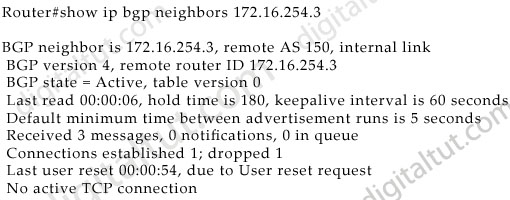
A. The router will not accept connections from the peer.
B. The router has sent out an active TCP connection request to the peer.
C. The router is listening on its server port for connection requests from the peer.
D. BGP can exchange routing information in this state.
Answer: C
Explanation
The BGP state in the output is “Active”, which means BGP speaker is attempting to initiate a TCP session with the BGP speaker it wants to peer with. If this can be done, the BGP state goes to OpenSent state.
Question 36
A router has two paths to reach another network in a different autonomous system. Neither route was generated by the local router and both routes have the same default weight and local preference values. Which statement is true about how BGP would select the best path?
A. If the command bgp always-compare-med has been given, then the router will prefer the route with the highest MED.
B. The router will prefer the route with the lower MED.
C. The router will prefer the shortest autonomous system path.
D. To influence one route to be preferred, its default local preference value will be changed via the use of the command bgp default local-preference 50.
Answer: C
Explanation
In the Route selection decision process, if the weight, local preference & route originated are the same then the shortest AS path will be chosen.
The full Route selection decision process is listed below:
1. Prefer highest weight (local to router)
2. Prefer highest local preference (global within AS)
3. Prefer route originated by the local router (next hop = 0.0.0.0)
4. Prefer shortest AS path
5. Prefer lowest origin code (IGP < EGP )
6. Prefer lowest MED (exchanged between autonomous systems)
7. Prefer EBGP path over IBGP path
8. Prefer the path through the closest IGP neighbor (IGP cost)
9. Prefer oldest route for EBGP paths
10. Prefer the path with the lowest neighbor BGP router ID
11. Prefer the path with the lowest neighbor IP address
Question 37
Refer to the exhibit. Which two statements are correct? (Choose two)
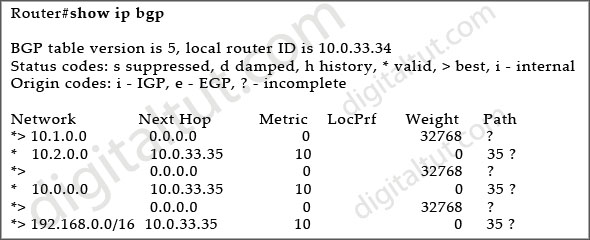
A. All six routes will be installed in the routing table.
B. Two routes will be installed in the routing table.
C. Four routes will be installed in the routing table.
D. All the routes were redistributed into BGP from an IGP.
E. All the routes were originated by BGP with the network command.
Answer: C D
Explanation
Only the valid & best routes (represented by *>) will be installed into the routing table -> C is correct.
The “?” under the “Path” column means that origin of the path is not clear. Usually, this is a router that is redistributed into BGP from an IGP. -> D is correct.
Question 38
Which two statements are true about IBGP neighbor relationships? (Choose two)
A. An EGP or static routing is required between IBGP neighbors.
B. A full-mesh IBGP requires that neighbor relationships be established between all BGP enabled routers in the autonomous system.
C. IBGP neighbors must be in different autonomous systems.
D. The BGP split-horizon rule specifies that routes learned via EBGP are never propagated to other IBGP peers.
E. The BGP split horizon rule specifies that routes learned via IBGP are never propagated to other IBGP peers.
Answer: B E
Question 39
Refer to the exhibit. Which two statements are true about the partial configuration that is provided. (Choose two)
A. All the configured neighbors are in autonomous system 100.
B. The peer group shortens the IBGP configuration.
C. The peer group shortens the EBGP configuration.
D. Only the outgoing filters are applied to BGP updates.
E. Three AS-path filters are applied to each BGP neighbor.
Answer: A B
Explanation
This is an IBGP peer group because the AS numbers in “router bgp {AS number}” and “neighbor internal remote-as {AS number} are the same -> A is correct.
A BGP peer group reduces the load on system resources by allowing the routing table to be checked only once, and updates to be replicated to all peer group members instead of being done individually for each peer in the peer group. In addition, a BGP peer group also simplifies the BGP configuration -> B is correct.
This is the process of creating a peer-group (used the output above):
Just one thing to notice is the last command “neighbor 171.69.232.55 filter-list 3 in” indicates the filter-list 3 will be applied for neighbor 171.69.232.55 while other neighbors will be applied filter-list 2 as the inbound filter-list (all neighbors use outbound filter-list 1).
Question 40
Observe the diagram. RTC is the hub router and RTA and RTB are the spokes. There are no virtual circuits between the spoke locations. What is needed to successfully route traffic to the 11.11.11.0/24 network from RTA?
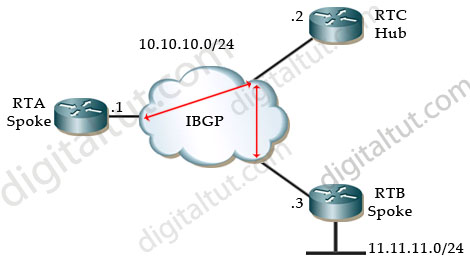 A. The neighbor 10.10.10.1 next-hop-self command on RTA.
A. The neighbor 10.10.10.1 next-hop-self command on RTA.
B. The neighbor 10.10.10.1 next-hop-self command on RTB.
C. The neighbor 10.10.10.1 next-hop-self command on RTC.
D. Nothing is required. This is the default behavior on this topology.
Answer: C
Explanation
The next-hop-self command must be used on RTC to specify RTC’s IP address as the source address in the packets sent to RTB (and RTB knows how to reach RTC but it does not know how to reach RTA).
Question 41
A router is running BGP and receives more than one route for a particular prefix. Assume all the routes for this prefix have the same attributes. Which three path features would be reasons be for the router to ignore some of the routes and not consider them as candidates for the best path? (Choose three)
A. paths that are marked as synchronized in the show ip bgp output
B. paths that are marked as not synchronized in the show ip bgp output
C. paths for which the NEXT_HOP is accessible
D. paths for which the NEXT_HOP is inaccessible
E. paths from an external BGP (eBGP) neighbor if the local autonomous system (AS) appears in the AS_PATH
F. paths from an internal BGP (iBGP) neighbor if the local autonomous system (AS) appears in the AS_PATH
Answer: B D E
Explanation
Only synchronized routes (answer B) with no AS loops (answer E) and a valid next hop (answer D) will be considered as candidates for the best path route selection decision process.
Question 42
Above is the output from show ip bgp neighbors command. What is line 21 stating about the BGP connection?
A. the number of consecutive TCP connections to the specified remote neighbor
B. the number of times the router has established a TCP connection
C. the number of total TCP connections that the router has
D. the number of neighbors that the router has
Answer: B
Question 43
Refer to the exhibit. Routing updates for the 192.168.1.0 network are being received from all three neighbors. Which statement is correct regarding the result of the configuration shown?
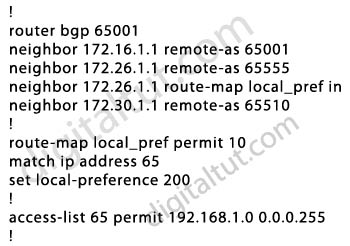
A. The router will prefer the next hop of 172.16.1.1 for packets destined for the 192.168.1.0 network.
B. The router will prefer the next hop of 172.26.1.1 for packets destined for the 192.168.1.0 network.
C. The router will advertise the 192.168.1.0 network only to 172.30.1.1.
D. The router will advertise the 192.168.1.0 network only to 172.26.1.1.
E. The router will prefer the next hop of 172.26.1.1 for packets except those destined for the
Answer: B
Explanation
The local-preference of the next hop 172.26.1.1 is set to 200, which is higher than the default value (100) so this path is preferred for packets destined to the 192.168.1.0 network.
Question 44
Refer to the exhibit. Which statement is true about the 6.6.6.0/24 prefix?
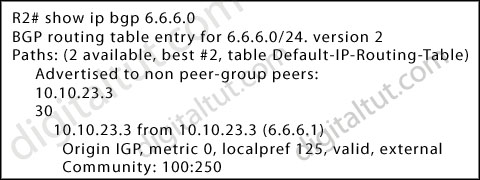
A. If another path advertises the 6.6.6.0/24 path and has the default local preference, that path is more preferred.
B. The command neighbor send-community is configured on BGP neighbor 10.10.23.3.
C. The route 10.10.23.3 is not being advertised to other BGP neighbors.
D. Route 6.6.6.0/24 is learned by an IBGP peer.
Answer: B
Explanation
By default, the community attributes are not advertised to BGP neighbors. But in the output we see the “Community: 100:250″ which means the command “neighbor … send-community” was used to send community attributes of the local router to the neighbor.
Question 45
Refer to the exhibit. Currently the two eBGP links between AS100 and AS200 have an average inbound load of 65% and 20% respectively. After further investigation, traffic to 10.10.1.16/28 accounts for 45%, and traffic to 10.10.1.32/28 and to 10.10.1.48/28 each account for 20% of the inbound load. The BGP attributes are currently set at their default values in both autonomous systems.
If you want to influence how AS200 sends traffic to AS100, which eBGP configurations would you configure in AS100 to influence AS200 to use the eBGP links more evenly? (Choose two.)
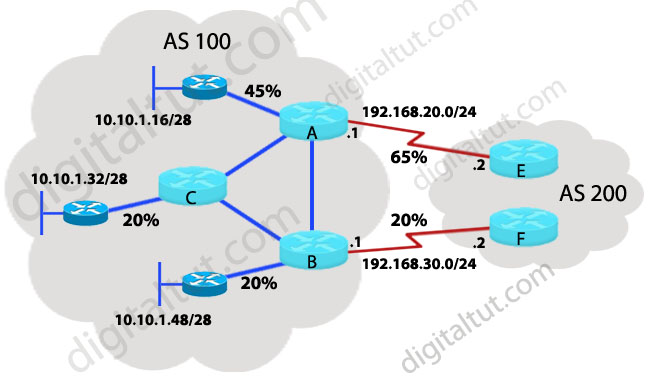 A. neighbor 192.168.30.2 route-map as_50 out
A. neighbor 192.168.30.2 route-map as_50 out
B. neighbor 192.168.20.2 route-map as_50 out
C. route-map as_50 permit 10
match ip address 50
set metric 150
access-list 50 permit 10.10.1.16 0.0.0.240
D. route-map as_50 permit 10
match ip address 50
set metric 150
access-list 50 permit 10.10.1.32 0.0.0.240
Answer: B D
Explanation
Note: The wildcard masks in the access-list are not correct, they should be 0.0.0.15 instead of 0.0.0.240.
First let’s recall about MED. If you want to influence external neighbors about the path it sends traffic then MED, also called the metric, should be used. A lower MED value is preferred over a higher value. The default MED value is 0.
Also, an important point I wish to notice in this question is: for Policy-based routing, if no match is made, the packets are forwarded normally via the routing table.
In answer C & B (combined), the MED for prefix 10.10.1.16/28 through router A is set to 150. This would make traffic for this route (45%) go through router B (because the MED default value is 0, which is lower than 150). Since the access-list will also NOT match prefixes: 10.10.1.32/28 & 10.10.1.48/28 – traffic for these two prefixes will be forwarded just normally (via the routing table) ->
Traffic for prefix: 10.10.1.32/28 will continue to go via the upper E-A link (now just 20% total load), while traffic for prefixes 10.10.1.16/28 and 10.10.1.48/28 will be going through the lower F-B link (now 65% total load) -> Original unbalanced (65/20) load is maintained, although it has been reversed between the upper (A-E) and lower (B-F) link -> C is not correct.
If answer D is applied for router A, the MED for 10.10.1.32 set to 150 would make traffic for this route go through router B (because the MED default value is 0, which is lower than 150). So router A will be responsible for 45% traffic and router B will receive 40% traffic -> D is correct.
Question 46
Refer to the exhibit. A client has asked you to consult on an eBGP loading question. Currently the AS 100 eBGP links have an average outbound load of 65% and 20% respectively. On further investigation, traffic from 10.10.24.0 accounts for 45%, and 10.10.25.0 and 10.10.32.0 accounts for 20% each of the outbound load. The customer wants to spread the load between the two eBGP links more evenly. The BGP attributes are currently set at their default values.
If you are located at AS 100 and want to influence how AS 100 sends traffic to AS 200, what BGP attribute could you configure to cause AS 100 outbound traffic to load the eBGP links more evenly?
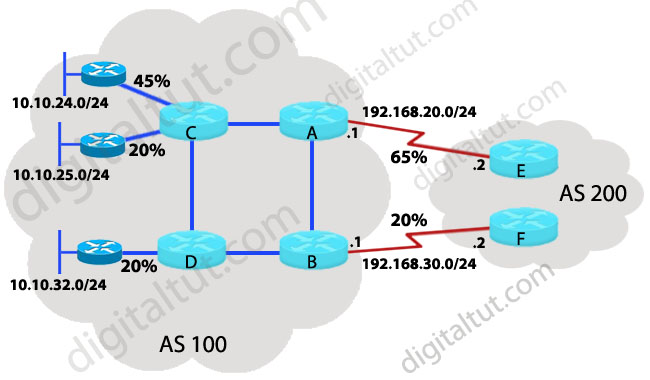 A. On router A, set the default local-preference to 50.
A. On router A, set the default local-preference to 50.
B. On router B, set the default metric to 150.
C. On router B, configure a route map for 10.10.25.0/24 with a local preference of 150 linked to neighbor 192.168.30.2.
D. On router B, set the default local-preference to 150.
Answer: C
Explanation
To make the eBGP links more evenly we should use the link B-F for network 10.10.25.0/24 so that the total traffic going through B-F link is about 40%. In this case we should apply a route map on B to set the local preference of 10.10.25.0/24 to a higher value than 100. But notice that we must use a second clause to permit other traffic if not they will be filtered out.
Note: The default value for local preference is 100. A path with higher local preference is preferred.
Question 47
Refer to the exhibit. AS 65500 is not advertising the prefix 192.168.12.0/22 to its provider. AS 65500 is running OSPF as its IGP.
Which of the following additions to the configuration is most likely to solve the problem?
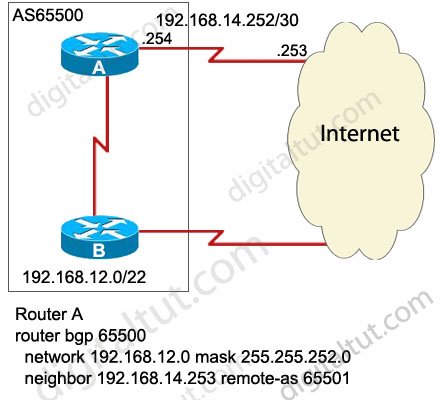 A. RouterA(config)#ip cef
A. RouterA(config)#ip cef
B. RouterA(config)#ip route 192.168.12.0 255.255.252.0 null 0
C. RouterA(config-router)#ebgp multihop 1
D. RouterA(config-router)#redistribute ospf 1
E. RouterA(config-router)#neighbor 192.168.14.253 next-hop-self
F. RouterA(config-router)#neighbor 192.168.14.253 local-as 65500
Answer: B
Explanation
The synchronization rule states “A BGP router should not use, or advertise to an external neighbor, a route learned by IBGP, unless that route is local or is learned from the IGP”. Notice that IGP here can be a static route.
In this case, unless there is an entry about network 192.168.12.0 in the routing table of RouterA, RouterA will not advertise this network to its EBGP -> B is correct (even if this static route points to Null0).
Note: Although this question states that OSPF is being used as IGP but for some reasons, network 192.168.12.0/22 is not advertised to RouterA -> RouterA does not have this route in its routing table.
Question 48
A company has a BGP network and a BGP route of 196.27.125.0/24 that should be propagated to all of the devices. The route is not now in any of the routing tables. The administrator determines that an access list is the cause of the problem. The administrator changes the access list to allow this route, but the route still does not appear in any of the routing tables. What should be done to propagate this route?
A. Clear the BGP session.
B. Use the release BGP routing command.
C. Use the service-policy command to adjust the QoS policy to allow the route to propagate.
D. Change both the inbound and outbound policy related to this route.
Answer: A
Explanation
BGP routing protocol is slow convergence due to its distance-vector nature, slow propagation of routing updates and enormous amounts of time it usually takes to detect a BGP neighbor loss so we should clear the BGP session. It is a method for soft reset the exchange of route refresh requests and routing information between BGP routers.
Note: The most popular command to clear the BGP session is clear ip bgp * command.
Question 49
Refer to the exhibit. What will RTB do with a packet sourced from within AS 64200 with a destination address of 192.168.25.1?
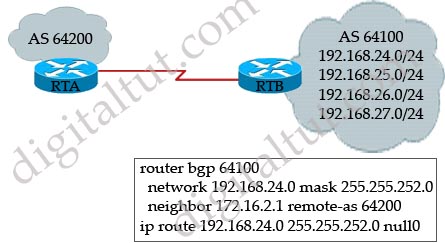
A. It will be dropped because network 192.168.25.0 is not in the RTA routing table.
B. It will be dropped because network 192.168.25.0 is not in the RTB routing table.
C. It will be forwarded to the null 0 interface of RTB and dropped.
D. It will be forwarded to the RTB 192.168.25.0 network.
Answer: D
Explanation
First I want to make it clear that the above configuration belongs to RTB (with AS 64100).
The “network” statement in other routing protocols (EIGRP, OSPF, RIP…) is used to enable routing protocol on the interfaces within that “network” statement. But in BGP, the function of a network statement is to tell the router to search the IP routing table for a particular network, and if that network is found, originate it into the BGP database. But notice that you must have an exact match in the IP routing table to appear the network in the BGP routing table (in this case we don’t see the auto-summary command so we suppose it is disabled in this case). For example:
+ network 10.10.10.0/8 will appear in BGP if network 10.10.10/8 appears in the IP routing table.
+ network 10.10.10.0/24 will appear in BGP if network 10.10.10.0/24 appears in the IP routing table.
Therefore, in this question the static route “ip route 192.168.24.0 255.255.252.0 null0″ was used to put a route to 192.168.24.0/22 into the routing table (although it points to Null0 but this command really makes that route appears in the routing table). Notice this network 192.168.24.0/22 also coverts network 192.168.25.0 -> RTB will forward that packet to 192.168.25.0 network.
Question 50
Which two statements are true about external BGP neighbor relationships? (Choose two)
A. Static routes or an interior gateway protocol is required between EBGP neighbors.
B. EBGP neighbors must be in different autonomous systems.
C. EBGP neighbors use TCP port 179 to exchange BGP routing tables.
D. Loopback addresses should be used between EBGP neighbors.
E. The BGP split-horizon rule specifies that routes learned via IBGP are never propagated to other EBGP peers.
F. When an EBGP neighbor receives an update from another EBGP neighbor, it should not forward the update to other EBGP neighbors.
Answer: B C
Explanation
An External BGP (EBGP) is a neighbor in another AS -> B is correct.
An underlying connection between two BGP speakers is established before any routing information is exchanged. This connection takes place on TCP port 179. Port 179 is also used to send routing updates (via TCP) -> C is correct.
Question 51
The command bgp always-compare-med is added to a router configuration. What will this command accomplish?
A. forces the router to compare metrics of routes from different autonomous systems
B. forces the router to compare the local preference of routes from different autonomous systems
C. forces the router to compare the weight of routes from different autonomous systems
D. forces the router to compare the communities of routes from different autonomous systems
Answer: A
Question 52
Which attribute must exist in the BGP update packet?
A. LOCAL, PREF
B. AGGREGATOR
C. AS_Path
D. Weight
Answer: C
Explanation
Origin, AS_Path, Next_Hop are well-known mandatory BGP attributes that all BGP Updates must include.
Note:
There are 4 BGP attribute types:
+ Well-known Mandatory: recognized by all implementations of BGP and must appear in a BGP update message. If missing, a notification error will be generated.
+ Well-Known Discretionary: recognized by all implementations of BGP but may not be sent in the BGP update message (include LOCAL_PREF, ATOMIC_AGGREGATOR).
+ Optional Transitive: may or may not be recognized by all BGP implementations. Because the attribute is transitive, BGP accepts and advertises the attribute even if it is not recognized (include Community attribte).
+ Optional Nontransitive: may or may not be recognized by all BGP implementations. Whether or not the receiving BGP router recognizes the attribute, it is nontransitive and is not passed along to other BGP peers (include MED).
Question 53
To enable BGP tunneling over an IPv4 backbone, the IPv4 address 192.168.30.1 is converted into a valid IPv6 address. Which three IPv6 addresses are acceptable formats for the IPv4 address? (Choose three)
A. 192.168.30.1:0:0:0:0:0:0
B. 0:0:0:0:0:0:192.168.30.1
C. ::192.168.30.1
D. C0A8:1E01::
E. 192.168.30.1::
F. ::C0A8:1E01
Answer: B C F
Question 54
A problem was reported that the 10.10.10.0/24 prefix was not injected into the local BGP table on RouterA. The following information is available from RouterA. Why is this prefix not in the local BGP table?
A. This route is not a BGP learned route.
B. The network command is wrong.
C. The 172.16.1.1 neighbor is down.
D. The prefix 10.10.10.0/24 is not ‘connected’ route.
Answer: B
Explanation
The correct network statement should be “network 10.0.0.0 255.255.255.0″. BGP will not advertise a prefix unless the prefix is also already installed in the routing table. Here the prefix installed in the routing table is “O 10.10.10.0/24″, but network command is 10.0.0.0 without a subnet mask. Therefore, the BGP process will use the default classful subnet mask of /8 and will not advertise it because it cannot find an exact prefix match in the routing table also. (Thanks dj for your explanation)
Question 55
Refer to the exhibit. All routers are configured for BGP. EBGP routes received on router R2 show up in the BGP table on routers R1 and R3 but not in their IP routing table. What would cause this? (Choose two)
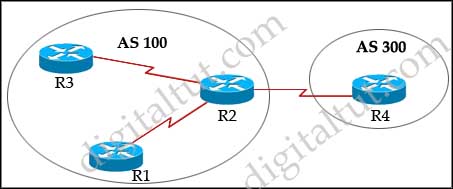
A. Synchronization in autonomous system 100 is turned is on.
B. Synchronization in autonomous system 100 is turned is off.
C. EBGP multihop is not configured on routers R1 and R3.
D. Routers R1 and R3 do not receive the same routes via an IGP.
E. The BGP routers in autonomous system 100 are not logically fully-meshed.
Answer: A D
Explanation
The synchronization rule states BGP should not advertise a route until all of the routers within the AS have learned about the route via an IGP so in this case if R1 and R3 have not learned that route via IGP, they cannot appear in their routing tables.
Question 56
Based on the R3 show ip bgp output, which statement is true?

A. The best path to reach the 192.168.11.0 prefix is via 10.200.200.11.
B. The best path to reach the 192.168.11.0 prefix is via 10.200.200.12.
C. The best path to reach the 192.168.11.0 prefix is via both 10.200.200.11 and 10.200.200.12; BGP will automatically load balance between the two.
D. The 192.168.11.0 and 192.168.12.0 prefixes were learned via EBGP from the 10.200.200.11 and 10.200.200.12 EBGP neighbors.
Answer: B
Refer to the exhibit. Router RIP is attempting to establish BGP neighbor relationships with routers RT1 and RT3. On the basis of the information that is presented in the exhibit, which two statements are true? (Choose two)


B – RTR has a BGP password set but neighbor 10.0.0.5 does not
C – RTR has a BGP password set but neighbor 10.0.0.1 has an incorrect password set
D – RTR has a BGP password set but neighbor 10.0.0.5 has an incorrect password set
E – Neighbor 10.0.0.1 has a BGP password set but RTR does not
F – Neighbor 10.0.0.5 has a BGP password set but RTR does not
Answer: A D
Explanation:
You can configure MD5 authentication between two BGP peers, MD5 authentication must be configured with the same password on both BGP peers; otherwise, the connection between them will not be made. If a router has a password configured for a peer, but the other peer does not, a message “No MD5 digest from…” will appear on the console while the routers attempt to establish a Multicast Source Discovery Protocol (MSDP) session between them. Therefore A is correct because RT1 (with an ip address of 10.0.0.1) is not configured with a password.
Similarly, if the two routers have different passwords configured, a message “Invalid MD5 digest from…” will appear on the screen.
Question 2
Refer to the exhibit diagram and configuration. RTB is summarizing its networks from AS 64100 with the aggregate-address command. However, the show ip route command on RTA reveals the RTB individual networks as well as its summary route. Which option would ensure that only the summary route would appear in the routing table of RTA?

B – Add the keyword summary-only to the aggregate-address command
C – Add a static route with a prefix of 192.168.24.0 255.255.252.0 pointing to the null interface
D – Create a route map permitting only the summary address
Answer: B
Explanation
When the aggregate-address command is used within BGP routing, the aggregated address is advertised, along with the more specific routes. The exception to this rule is through the use of the summary-only command. The “summary-only” keyword suppresses the more specific routes and announces only the summarized route.
Question 3
Refer to the exhibit The neighbor 10.1.1.1 weight 200 BGP configuration command has been configured on router A. What will be the result of this configuration?

B – Router A will prefer the path through router C for network 172.20.0.0
C – Packets from router D will prefer the path through router B for networks advertised by router A
D – Packets from router D will prefer the path through router C for networks advertised by router A
Answer: A
Explanation
The weight attribute is a special Cisco attribute that is used in the path selection process when there is more than one route to the same destination. The higher the weight value, the better the path. The default weight is 0. Therefore, by configuring weight 200 to the neighbor 10.1.1.1, router A will prefer the path through router B for network 172.20.0.0 then the path through router C.
The weight attribute is local to the router and not propagated to other routers. In this case the weight is local to router A so it has no effect on the decision of transferring packets from router D.
Question 4
Based on the show ip bgp summary output. which two statements are true? (Choose two)

B – The BGP session to the 10.2.2.2 neighbor is established
C – The BGP session to the 10.3.3.3 neighbor is established
D – The router is attempting to establish a BGP peering session with the 10.1.1.1 neighbor
E – The BGP session to the 10.3.3.3 neighbor is established, but the router has not received any BGP routing updates from the 10.3.3.3 neighbor
F – The router is attempting to establish a BGP peering session with the 10.2.2.2 neighbor
Answer: A F
Explanation
The main point of this question is the “State/PfxRcd” column, which shows the BGP states. Below is the list of BGP states in order, from startup to peering:
1 – Idle: the initial state of a BGP connection. In this state, the BGP speaker is waiting for a BGP start event, generally either the establishment of a TCP connection or the re-establishment of a previous connection. Once the connection is established, BGP moves to the next state.
2 – Connect: In this state, BGP is waiting for the TCP connection to be formed. If the TCP connection completes, BGP will move to the OpenSent stage; if the connection cannot complete, BGP goes to Active
3 – Active: In the Active state, the BGP speaker is attempting to initiate a TCP session with the BGP speaker it wants to peer with. If this can be done, the BGP state goes to OpenSent state.
4 – OpenSent: the BGP speaker is waiting to receive an OPEN message from the remote BGP speaker
5 – OpenConfirm: Once the BGP speaker receives the OPEN message and no error is detected, the BGP speaker sends a KEEPALIVE message to the remote BGP speaker
6 – Established: All of the neighbor negotiations are complete. You will see a number (2 in this case), which tells us the number of prefixes the router has received from a neighbor or peer group.
Question 5
Which command displays the IBGP and EBGP neighbors that are configured?
A – show ip bgp
B – show ip bgp paths
C – show ip bgp peers
D – show ip bgp summary
Answer: D
Explanation
The picture below shows the output of the show ip bgp summary


Question 6
BGP contains two paths to a destination. Assuming both routes were originated locally and have an equal weight. what will be the next determining factor in choosing the best path?
A – lowest MED
B – highest local preference
C – lowest neighbor IP address
D – lowest origin code
E – shortest AS-path
Answer: B
Explanation
Memorizing the BGP decision process steps is very useful and you should remember them. The table below lists the complete path selection process:
1. Weight (Bigger is better)
2. Local preference (Bigger is better)
3. Self originated (Locally injected is better than iBGP/eBGP learned)
4. AS-Path (Smaller is better)
5. Origin (Prefer ORIGIN code I over E, and E over ?)
6. MED (Smaller is better)
7. External (Prefer eBGP over iBGP)
8. IGP cost (Smaller is better)
9. EBGP Peering (Older is better)
10. RID (Lower is better)
Question 7
Which BGP path attribute is Cisco proprietary?
A. weight
B. MED
C. local preference
D. origin
E. next-hop
F. AS-path
Answer: A
Explanation
The weight attribute is a Cisco proprietary technology. This attribute is local to a router and is not advertised to neighboring routers. If the router learns about more than one route to the same destination, the route with the highest weight will be preferred and will be installed in the routing table. By default, the value of weight is 0 and the range is from 0 to 65535.
The route with the highest weight will be installed in the IP routing table.
Question 8
Which attribute must exist in the BGP update packet?
A. LOCAL_PREF
B. AGGREGATOR
C. AS_Path
D. Weight
Answer: C
Explanation
Origin, AS_Path, Next_Hop are well-known mandatory BGP attributes that all BGP Updates must include.
Note:
There are 4 BGP attribute types:
+ Well-known Mandatory: recognized by all implementations of BGP and must appear in a BGP update message. If missing, a notification error will be generated.
+ Well-Known Discretionary: recognized by all implementations of BGP but may not be sent in the BGP update message (include LOCAL_PREF, ATOMIC_AGGREGATOR).
+ Optional Transitive: may or may not be recognized by all BGP implementations. Because the attribute is transitive, BGP accepts and advertises the attribute even if it is not recognized (include Community attribte).
+ Optional Nontransitive: may or may not be recognized by all BGP implementations. Whether or not the receiving BGP router recognizes the attribute, it is nontransitive and is not passed along to other BGP peers (include MED).
Question 9
When the BGP path selection process is being performed on a Cisco router, which BGP attribute is used first when determining the best path?
A. local preference
B. MED
C. weight
D. origin
E. next-hop
F. AS-path
Answer: C
Explanation
Weight is the first attribute BGP uses in the route selection process. Route with a higher weight is preferred when multiple routes exist to the same destination.
Question 10
Which BGP attribute will not be advertised in routing updates to its neighboring routers?
A. weight
B. local preference
C. origin
D. AS_path
E. next hop
Answer: A
Question 11
Study the configuration presented in the exhibit carefully. What is the objective of the route map named test?
| router bgp 50001 network 10.0.0.0 network 172.16.0.0 neighbor 10.1.1.1 remote-as 5003 neighbor 10.1.1.1 route-map test out ! access-list 1 permit 10.0.0.0 access-list 2 permit any ! route-map test permit 10 match ip address 1 set metric 200 ! route-map test permit 20 match ip address 2 |
B. marks the 10.0.0.0/8 prefix received from the 10.1.1.1 neighbor with a MED of 200
C. marks the 10.0.0.0/8 prefix advertised to the 10.1.1.1 neighbor with a MED of 200
D. marks all prefixes advertised to the 10.1.1.1 neighbor with a MED of 200
Answer: C
Explanation
From the command “neighbor 10.1.1.1 route-map test out” we learn the “test” route map is applied on the outbound direction to the neighbor 10.1.1.1. In the “test” route map, we see 3 statements:
“route-map test permit 10
match ip address 1
set metric 200″
They mean “if the access list 1 is matched, set the Multi Exit Discriminator (MED) of that route to 200″.
Question 12
What technique should be used on BGP edge routers to prevent a multi-homed autonomous system from becoming a transit system?
A. Advertise with a high MED value all networks that are discovered via external BGP.
B. Remove the AS-Path information on all routes in the BGP table prior to advertising externally.
C. Only advertise networks externally if they have been discovered via internal BGP.
D. Use an outgoing distribution list to filter all networks not originating from inside the autonomous system.
E. Set the no-export community attribute on all networks that are advertised externally.
F. Set the origin code to incomplete for all networks that are discovered via external BGP.
Answer: D
Explanation
A transit AS is an AS that routes traffic from one external AS to another external AS. Let’s see an example below:

There are two popular ways to prevent a multi-homed autonomous system from becoming a transit system:
+ Use a distribute-list or filter-list to filter all networks not originating from inside the autonomous system.
+ Use the no-export community attribute on all networks not originating from inside the autonomous system.
Answer E seems to be correct but in fact it is not because “all networks that are advertised externally” include networks originating from inside and outside our AS. We should only filter networks originating from outside our AS. In some cases, the routers in our company may advertise some internal networks (for remote access, for example).
Question 13
Refer to the exhibit. By default, when RTB passes BGP advertisements from RTA about network 192.168.2.0 to RTC, what address will be listed as the next-hop address?

B. 10.1.1.2
C. 192.168.1.49
D. 192.168.1.50
Answer: D
Explanation
This is a rule for BGP advertisement:
“For EBGP, the next hop is always the IP address of the neighbor specified in the neighbor command. For IBGP, the protocol states that the next hop advertised by EBGP should be carried into IBGP“.
In this case, when RTA (in AS 65000, which is an EBGP for RTB) advertises a route to RTB, it specifies its interface (192.168.1.50) as the next-hop. But when RTB passes this advertisement to RTC, it specifies RTA interface (also 192.168.1.50) as the next-hop (IBGP). This can cause some routing failures because if RTC does not know a way to reach RTA interface via IGP (OSPF, EIGRP…), it will drop that packet. To fix this problem, add the “neighbor 10.1.1.2 next-hop-self” command under BGP mode in RTB.
Question 14
What are the two reasons for the appearance of 0.0.0.0 as the next hop for a network in the show ip bgp command output? (Choose two)
A. The network was originated via redistribution of an interior gateway protocol into BGP.
B. The network was defined by a static route.
C. The network was originated via a network or aggregate command.
D. The network was learned via EBGP.
E. The network was learned via IBGP.
Answer: A C
Question 15
Which BGP attribute is used by BGP to prevent routing loops?
A. AS-path
B. next-hop
C. MED
D. weight
E. local preference
F. origin
Answer: A
Explanation
The AS-PATH attribute is used to prevent BGP routing loops. When receiving an BGP advertisement, the router checks the AS-PATH attribute, if it see it’s own AS number in the AS-Path then it is a routing loop so the router will not install this route in its BGP table.
Question 16
Refer to the exhibit. It is desired to set up a BGP neighbor relationship between routers R1 and R4. BGP packets between them could travel through R2 or R3. What is the simplest configuration that will allow for failover?

B. Install a direct connection between R1 and R4.
C. Configure loopback interfaces on R1 and R4 to provide the update source address for BGP packets.
D. Configure only one neighbor relationship between R1′s 192.168.1.2 interface and R4′s 172.16.10.2 interface.
Answer: C
Explanation
Assume R4 only uses this configuration:
R4(config)#router bgp 65000
R4(config-router)#neighbor 192.168.1.2 remote-as 65000
Then if R1 sends BGP packets to R4 via R3, the source IP address of the packets is 192.168.2.2. But R4 does not recognize this IP address because 192.168.2.2 is not configured in the “neighbor” command of R4. Therefore the IBGP session between R1 & R4 is not established -> these packets will be dropped.
The simplest configuration to allow R1 and R4 communicate via both R2 & R3 is to use a loopback interface address rather than a physical interface address as the source IP address for all BGP packets. To do this, use the command:
R4(config-router)#neighbor 1.1.1.1 update-source loopback0
(In which 1.1.1.1 is the loopback interface of R1). In practical, we should establish neighborship with the loopback interface rather than the physical interface because if the physical interface goes down, the neighborship would be lost while a loopback interface never goes down.
Also, when configuring “1.1.1.1″ as the neighbor, you must configure on R1 the “neighbor 4.4.4.4 update-source loopback0” command so that the source IP address of packets sent from R1 (loopback0 – 1.1.1.1) will be matched with the neighbor command configured on R4.
Question 17
Refer to the exhibit. Network 10.0.0.0/8 is being advertised to autonomous system 65550 via both external links. Which statement about the preferred path to the 10.0.0.0/8 network is true?

B. Router R1 will be preferred because it has the lower neighbor IP address.
C. Router R1 will be preferred because it has a lower local preference.
D. Router R2 will be preferred because its neighbor has a lower autonomous system number.
E. Router R2 will be preferred because it has the higher neighbor IP address.
F. Router R2 will be preferred because it has a higher local preference.
Answer: F
Explanation
Local preference is an indication to the AS about which path has preference to exit the AS in order to reach a certain network. A path with a higher local preference is preferred more. The default value for local preference is 100.
Unlike the weight attribute, which is only relevant to the local router, local preference is an attribute that routers exchange in the same AS. The local preference is set with the “bgp default local-preference value” command.
In this case, both R1 & R2 learn about the network 10.0.0.0/8 but R2 has higher local-preference so R2 will be chosen as the preferred exit point from AS 65550.
Question 18
During BGP configuration on a router that has peered with other BGP speakers, the BGP command aggregate-address 172.32.0.0 255.255.252.0 is issued. However, the peers do not receive this aggregate network in BGP advertisements. Also, the router does not have this aggregate network in its BGP table. Which option indicates a possible reason this command did not cause the router to advertise the aggregate network to its peers?
A. Interface NULL 0 is likely shutdown.
B. The BGP command no synchronization is missing.
C. The BGP command no auto-summary is missing.
D. Subnets of 172.32.0.0/22 do not exist in the BGP table.
E. The IGP running on this router does not have network 172.32.0.0/22 installed.
F. The next hop IP address must be a loopback address.
Answer: D
Explanation
A rule of aggregation is “Aggregation applies only to routes that exist in the BGP routing table. An aggregated route is forwarded if at least one more specific route of the aggregation exists in the BGP routing table.
Question 19
Which two methods advertise internal networks to external ISPs via BGP? (Choose two)
A. using aggregate routes
B. disabling synchronization
C. forcing the next-hop address
D. defining routes via the network statement
Answer: A D
Question 20
Which BGP command provides the router ID, local preference, next hop, and BGP path in its output?
A. show ip route bgp
B. show ip bgp
C. show ip bgp neighbors
D. show ip bgp summary
Answer: B
Explanation
The “show ip bgp” command is used to display entries in the BGP routing table. An example of the “show ip bgp” output is shown below:

In the output you can see the router ID, local preference, next hop, and BGP path.
Question 21
Which option is true regarding the synchronization rule?
A. Do not use or internally advertise a route until the route is learned from a source other than BGP.
B. Do not use or advertise a route until the route is learned from a BGP peer.
C. Do not use or advertise routes marked PARTIAL.
D. Wait until a CONFIRM message is received before using routes from BGP neighbors.
Answer: A
Explanation
The complete synchronization rule is “A BGP router should not use, or advertise to an external neighbor, a route learned by IBGP, unless that route is local or is learned from the IGP.”
With the default of synchronization disabled, BGP can use and advertise to external BGP neighbors routes learned from an IBGP neighbor that are not present in the local routing table
The “synchronization” here means “synchronization between iBGP with its IGP (such as OSPF, EIGRP…)
You can disable synchronization if one of the following conditions is true:
Your AS does not pass traffic from one AS to another AS.
All the transit routers in your AS run BGP.
Note: BGP synchronization is disabled by default in Cisco IOS Software Release 12.2(8)T and later.
Question 22
Refer to the exhibit. Router RT-1 and router RT-2 both advertise network 131.25.0.0/16 to router RT-3 via internal BGP. What is the reason that router RT-3 chose router RT-1 as its best path to network 131.25.0.0/16.

B. It advertises the best origin code.
C. It advertises the best MED.
D. It advertises the best local preference.
E. It has a better router ID.
F. It advertises a lower autonomous system.
Answer: E
Explanation
Recall the route selection decision process in BGP:
Consider only (synchronized) routes with no AS loops and a valid next hop, and then:
| Route selection decision process (from top to bottom) | In this question… |
| Prefer highest weight (local to router) | RT-3 is not an exit point |
| Prefer highest local preference (global within AS) | same local preference of 100 |
| Prefer route originated by the local router (next hop = 0.0.0.0) | both routes are from IBGP |
| Prefer shortest AS path | same |
| Prefer lowest origin code (IGP < EGP ) | both are incomplete (EGP > IGP > Incomplete) |
| Prefer lowest MED (exchanged between autonomous systems) | both MEDs are 0 |
| Prefer EBGP path over IBGP path | both are IBGP |
| Prefer the path through the closest IGP neighbor (IGP cost) | not used because IBGPs are used |
| Prefer oldest route for EBGP paths. | not used |
| Prefer the path with the lowest neighbor BGP router ID. | the router-id 162.105.11.1 is lower than 165.105.3.2 |
| Prefer the path with the lowest neighbor IP address. |
Refer to the exhibit. Router RT-1 chooses one path to network 198.133.219.0/24. Indicate the reason Router RT-1 chooses this “best” path.

B. In making its decision about the best path, RT-1 gives precedence to the BGP MED values.
C. IP address 128.107.2.2 is lower than 128.107.255.2.
D. In making its decision about the best path, RT-1 prefers the IGP metrics.
E. RT-1 prefers internal BGP routes.
F. IP address 128.107.254.2 is lower than 128.107.255.2.
Answer: A
Explanation
As explained in question 3, the IGP is preferred over incomplete.
Question 24
The Border Gateway Protocol (BGP) is the core routing protocol of the Internet. Refer to the exhibit. Routers A and B are running BGP but the session is active. What command needs to be added to establish the BGP session?

| hostname A ! interface loopback 0 ip address 10.10.10.2 255.255.255.255 ! interface serial 0/0 ip address 172.16.10.2 255.255.255.252 ! interface serial 0/1 ip address 172.16.10.5 255.255.255.252 ! router bgp 65444 neighbor 10.10.10.1 remote-as 65111 neighbor 10.10.10.1 update-source loopback 0 neighbor 10.10.10.1 ebgp-multihop |
ip route 10.10.10.1 255.255.255.255 s0/ 1
B. no synchronization
C. network 10.10.10.0
D. neighbor 10.10.10.1 next-hop-self
Answer: A
Explanation
In this case we want to achieve load balancing so the loopback interface must be used to establish neighborship.
If we check the routing table of router A, we will see that there is no entry for the remote network 1.1.1.1/32 -> router A does not know how to reach the loopback interface on router B -> a TCP session can’t be established to router B. Therefore we need to tell router A a way to reach router B.
Question 25
Refer to the exhibit. Autonomous systems 200 and 300 have EBGP sessions established with their directly connected routers in autonomous system 100. IGP has been configured on all routers in autonomous system 100 and they successfully exchange routing updates. Traffic originated in autonomous system 200 cannot reach the destination autonomous system 300. What configuration should be done on the routers in autonomous system 100 in order for the traffic coming from autonomous system 200 to be forwarded to autonomous system 300?

B. IBGP session must be established between routers R1 and R3, and the synchronization must be turned off.
C. IBGP session must be established between routers R1 R2 and R2 R3. and the synchronization must be turned on.
D. IBGP session must be established between routers R1 R2 and R2 R3, and the synchronization must be turned off.
E. IBGP speakers within autonomous 100 must be fully meshed, and the synchronization must be turned on.
F. IBGP speakers within autonomous 100 must be fully meshed, and the synchronization must be turned off.
Answer: F
Explanation
The synchronization rule states that if an AS provides transit service to another AS, BGP should not advertise a route until all of the routers within the AS have learned about the route via an IGP. To understand why this rule exists, let’s take an example if this rule is not there.

Now Rt-B really wants to send traffic to 1.1.1.0 so it will send to R3. R3 does a look up and sees that the network can be reachable via R1. It then does a lookup for R1′s IP address and sees that it is reachable via R2 -> so it forwards packets to R2. But R2, running IGP (like OSPF), does not find an entry for 1.1.1.0 so R2 drops all the packets for that network – a black-hole is created!
That is why the BGP synchronization rule is born. With this rule, when R3 receives an advertisement for 1.1.1.0 from R1, it adds that route to its BGP table and before sending advertisement to RT-B, it first checks its IGP routing table to see whether an entry exists for that route. In this example, R3′s IGP routing table does not know how to reach 1.1.1.0 so R3 will not advertise this network to RT-B. This route is only advertised to RT-B when IGP makes an entry in the routing table for 1.1.1.0.
Well, now you understand the importance of BGP Synchronization rule but now I wish to explain why this rule causes trouble in fully-meshed IBGP!

Note: A “fully-meshed” can be a physical fully-meshed topology or a topology where all routers in the same AS established IBGP connections with each other (although they do not need to be directly connected). So in the topology above, the connection between R1 & R3 is represented by a dashed line, which means it can be physically connected or not (but an IBGP connection must be established on both routers).
Therefore if all routers in AS 100 is fully-meshed, the synchronization rule must be turned off -> F is correct.
Question 26
Which one of the following statements about BGP is FALSE?
A. BGP uses TCP port 179.
B. BGP ensures reliability of updates by using the reliable transport services of TCP.
C. The network command with the mask option never installs a prefix into the BGP table unless there is a matching prefix exists in the IP route table.
D. A TCP connection is required before exchanging updates.
E. BGP uses notification and the update messages to establish and maintain the BGP neighbor relationship.
Answer: E
Explanation
An underlying connection between two BGP speakers is established before any routing information is exchanged. This connection takes place on TCP port 179.
Unlike other routing protocols, the router must be manually configured with the neighbor information on both sides of the connection -> E is correct (which is FALSE in this question)
Question 27
Which BGP option is required when load sharing over multiple equal-bandwidth parallel links from a single CE router to a single ISP router over eBGP?
A. eBGP Multipath
B. eBGP Multihop
C. BGP Synchronization
D. Public AS numbers
Answer: B
Explanation
The eBGP multihop allows a neighbor connection between two external peers that do not have direct connection. The multihop is only for eBGP and not for iBGP. For example, in the topology below router A wants to establish neighbor relationship with the loopback0 of router B (to allow load balancing), which does not have direct connection so it must use “ebgp-multihop”

| A# int loopback 0 ip address 10.10.10.2 255.255.255.255 router bgp 1 neighbor 10.10.10.1 remote-as 2 neighbor 10.10.10.1 ebgp-multihop neighbor 10.10.10.1 update-source loopback 0 network 10.10.10.2 mask 255.255.255.255 ip route 10.10.10.1 255.255.255.255 172.16.10.1 ip route 10.10.10.1 255.255.255.255 172.16.10.6 |
B# int loopback 0 ip address 10.10.10.1 255.255.255.255 router bgp 2 neighbor 10.10.10.2 remote-as 1 neighbor 10.10.10.2 ebgp-multihop neighbor 10.10.10.2 update-source loopback 0 network 10.10.10.1 mask 255.255.255.255 ip route 10.10.10.2 255.255.255.255 172.16.10.2 ip route 10.10.10.2 255.255.255.255 172.16.10.5 |
| B# router bgp 2 neighbor 172.16.10.2 remote-as 1 |
Question 28
Which statement is true about IBGP routers?
A. They must be fully meshed.
B. They can be in a different AS.
C. They must be directly connected,
D. They do not need to be directly connected.
Answer: D
Question 29
Refer to the exhibit. On the basis of the configuration that is provided, how would the BGP updates that come from router R1 be replicated inside autonomous system 65200?

B. All BGP updates that are received on router R2 will not be sent to routers R3 and R4.
C. All BGP updates that are received on router R2 will be sent directly to router R5.
D. None of the BGP updates that are received on router R2 will ever be received by router R5.
Answer: D
Explanation
All BGP updates that are received on router R2 will be sent to routers R3 and R4 but R3 & R4 will not forward those BGP updates to R5. This is called the BGP split-horizon rule (which states that a route learned from one IBGP neighbor will not be advertised to another IBGP neighbor) -> A is not correct.
The BGP updates received on router R2 will be sent to R3 and R4 without violating the BGP split-horizon rule because R2 receives updates from an EBGP (R1), not IBGP -> B is not correct.
From the configuration of R2, we learn that R2 did not establish neighbor relationship with R5 so they are not neighbors -> no BGP updates will be sent from R2 to R5 -> C is not correct.
The BGP split-horizon rule prevents updates received on R2 from being sent to R5 -> D is correct.
Question 30
The 192.168.0.0 network is not being propagated throughout the network. Observe the BGP configuration commands from the advertising router. What is the reason the 192.168.0.0 route is not being advertised?
| router bgp 65111 neighbor 172.16.1.1 remote-as 65111 neighbor 172.16.2.1 remote-as 65112 network 192.168.0.0 network 10.0.0.0 ! ip route 192.168.0.0 255.255.0.0 null0 |
B. The network 192.168.0.0 statement is missing mask 0.0.255.255.
C. The network 10.0.0.0 statement is missing mask 255.0.0.0.
D. The network 10.0.0.0 statement is missing mask [IMG]resource://skype_ff_extension-at-jetpack/skype_ff_extension/data/call_skype_logo.png[/IMG]0.255.255.255.
E. The auto-summary configuration is missing.
Answer: A
Explanation
The “network” statement in other routing protocols (EIGRP, OSPF, RIP…) is used to enable routing protocol on the interfaces within that “network” statement. But in BGP, the function of a network statement is to tell the router to search the IP routing table for a particular network, and if that network is found, originate it into the BGP database. But notice that you must have an exact match in the IP routing table to appear the network in the BGP routing table (in this case we don’t see the auto-summary command so we suppose it is disabled in this case). For example:
+ network 10.10.10.0/8 will appear in BGP if network 10.10.10.0/8 appears in the IP routing table.
+ network 10.10.10.0/24 will appear in BGP if network 10.10.10.0/24 appears in the IP routing table.
Therefore, in this question the static route “ip route 192.168.0.0 255.255.0.0 null0″ was used to put a route to 192.168.0.0/16 into the routing table (although it points to Null0 but this command really makes that route appears in the routing table). But the “network 192.168.0.0″ statement tells the router to lookup network 192.168.0.0/24 (if the network statement under BGP-mode does not specify a subnet mask, the default subnet mask of that class will be used). The router only finds network 192.168.0.0/16 -> The network 192.168.0.0 is not being propagated throughout the network because of the mismatch of the subnet mask -> A is correct.
Just for your information, in fact we have to suppose there is no entry of the network 192.168.0.0/24 exist in the routing table except the static route “ip route 192.168.0.0 255.255.0.0 null0″. If such an entry exists (for example, a directly connected entry like “C 192.168.0.0/24 is directly connected”) then the router still advertises it with the “network 192.168.0.0″ (without mask 255.255.0.0) command.
Question 31
Which two conditions can cause BGP neighbor establishment to fail? (Choose two)
A. There is an access list blocking all TCP traffic between the two BGP neighbors.
B. The IBGP neighbor is not directly connected.
C. BGP synchronization is enabled in a transit autonomous system with fully-meshed IBGP neighbors.
D. The BGP update interval is different between the two BGP neighbors.
E. The BGP neighbor is referencing an incorrect autonomous system number in its neighbor statement.
Answer: A E
Explanation
An underlying connection between two BGP speakers must be established before any routing information is exchanged. This connection takes place on TCP port 179 so if an access list blocks all TCP traffic between the two BGP neighbors, BGP neighbor relationship can not be established -> A is correct.
The IBGP neighbors don’t need to be directly connected -> B is not correct.
BGP synchronization only prevents routes sent to other EBGP neighbors before that route exists in the routing table. It doesn’t prevent BGP neighbor relationship -> C is not correct.
After the first initial exchange (which exchanges routes and synchronize their tables), a BGP speaker will only send further updates upon a change in the network topology -> BGP does not have a fixed update interval -> D is not correct.
BGP neighbor relationship is established when both ends (routers) are manually configured with the “neighborneighbor-IP remote-as neighbor-AS” command on both sides of the connection. If the neighbor-AS is wrong, the neighbor relationship can not be established -> E is correct.
Question 32
Which statement is true about EBGP?
A. An internal routing protocol can be used to reach an EBGP neighbor.
B. The next hop does not change when BGP updates are exchanged between EBGP neighbors.
C. A static route can be used to form an adjacency between neighbors.
D. EBGP requires a full mesh.
Answer: C
Explanation
When two EBGP neighbors want to establish neighbor relationship without using the directly connected interfaces (for example, use loopback interface), they must tell each other how to reach their interfaces. A static route is the most simple way to do this, especially when they are in different ASs.
Question 33
Why should iBGP sessions be fully meshed within a Transit AS?
A. BGP requires redundant TCP sessions between iBGP peers.
B. A full mesh allows for optimal routing within the Transit AS.
C. Routes learned via iBGP are never propagated to other eBGP peers.
D. Routes learned via iBGP are never propagated to other iBGP peers.
E. Routes learned via eBGP are never propagated to other iBGP peers.
Answer: D
Explanation
BGP split-horizon rule states that a route learned from one IBGP neighbor will not be advertised to another IBGP neighbor so IBGP sessions should be fully meshed. For example in the topology below, routes learned from R1 about AS 200 will be advertised to R2. For R2, the route learned from R1 is a route learned from one IBGP neighbor so R2 will not advertise this route to R3 and AS 100 can never be a transit AS -> IBGP sessions should be fully meshed within a transit AS -> D is correct.

Question 34
Which BGP feature should be used to avoid high memory utilization on a router?
A. soft-reconfiguration
B. route refresh
C. BGP communities
D. full-mesh BGP peering
Answer: B
Explanation
BGP routers have enormous routing tables so it uses much memory to proceed these routes. When a BGP policy is changed, the BGP session needs to be reset for the policy to take effect. But the resetting results in route churn and route flapping. There are two ways to clear a BGP session without resetting the TCP session between them (this is often called “soft reset”):
Soft-reconfiguration: stores all received (inbound) routing policy updates without modification in a table so that when a new filter is applied, the router will use this table to calculate the changes without resetting the TCP session between the two BGP peers . This is a memory-intensive (high memory utilization) method and is not recommended.
Route-refresh: allows a BGP router to request a remote peer resend its BGP Adj-RIB-Out. This allows the BGP router to reapply the inbound policy. The route-refresh capability requires no extra memory on the local router
Question 35
For the accompanying router output, which of the following statements describes the state that neighbor 172.16.254.3 is in?

A. The router will not accept connections from the peer.
B. The router has sent out an active TCP connection request to the peer.
C. The router is listening on its server port for connection requests from the peer.
D. BGP can exchange routing information in this state.
Answer: C
Explanation
The BGP state in the output is “Active”, which means BGP speaker is attempting to initiate a TCP session with the BGP speaker it wants to peer with. If this can be done, the BGP state goes to OpenSent state.
Question 36
A router has two paths to reach another network in a different autonomous system. Neither route was generated by the local router and both routes have the same default weight and local preference values. Which statement is true about how BGP would select the best path?
A. If the command bgp always-compare-med has been given, then the router will prefer the route with the highest MED.
B. The router will prefer the route with the lower MED.
C. The router will prefer the shortest autonomous system path.
D. To influence one route to be preferred, its default local preference value will be changed via the use of the command bgp default local-preference 50.
Answer: C
Explanation
In the Route selection decision process, if the weight, local preference & route originated are the same then the shortest AS path will be chosen.
The full Route selection decision process is listed below:
1. Prefer highest weight (local to router)
2. Prefer highest local preference (global within AS)
3. Prefer route originated by the local router (next hop = 0.0.0.0)
4. Prefer shortest AS path
5. Prefer lowest origin code (IGP < EGP )
6. Prefer lowest MED (exchanged between autonomous systems)
7. Prefer EBGP path over IBGP path
8. Prefer the path through the closest IGP neighbor (IGP cost)
9. Prefer oldest route for EBGP paths
10. Prefer the path with the lowest neighbor BGP router ID
11. Prefer the path with the lowest neighbor IP address
Question 37
Refer to the exhibit. Which two statements are correct? (Choose two)

A. All six routes will be installed in the routing table.
B. Two routes will be installed in the routing table.
C. Four routes will be installed in the routing table.
D. All the routes were redistributed into BGP from an IGP.
E. All the routes were originated by BGP with the network command.
Answer: C D
Explanation
Only the valid & best routes (represented by *>) will be installed into the routing table -> C is correct.
The “?” under the “Path” column means that origin of the path is not clear. Usually, this is a router that is redistributed into BGP from an IGP. -> D is correct.
Question 38
Which two statements are true about IBGP neighbor relationships? (Choose two)
A. An EGP or static routing is required between IBGP neighbors.
B. A full-mesh IBGP requires that neighbor relationships be established between all BGP enabled routers in the autonomous system.
C. IBGP neighbors must be in different autonomous systems.
D. The BGP split-horizon rule specifies that routes learned via EBGP are never propagated to other IBGP peers.
E. The BGP split horizon rule specifies that routes learned via IBGP are never propagated to other IBGP peers.
Answer: B E
Question 39
Refer to the exhibit. Which two statements are true about the partial configuration that is provided. (Choose two)
| router bgp 100 neighbor internal peer-group neighbor internal remote-as 100 neighbor internal update-source loopback 0 neighbor internal route-map set-med out neighbor internal filter-list 1 out neighbor internal filter-list 2 in neighbor 171.69.232.53 peer-group internal neighbor 171.69.232.54 peer-group internal neighbor 171.69.232.55 peer-group internal neighbor 171.69.232.55 filter-list 3 in |
B. The peer group shortens the IBGP configuration.
C. The peer group shortens the EBGP configuration.
D. Only the outgoing filters are applied to BGP updates.
E. Three AS-path filters are applied to each BGP neighbor.
Answer: A B
Explanation
This is an IBGP peer group because the AS numbers in “router bgp {AS number}” and “neighbor internal remote-as {AS number} are the same -> A is correct.
A BGP peer group reduces the load on system resources by allowing the routing table to be checked only once, and updates to be replicated to all peer group members instead of being done individually for each peer in the peer group. In addition, a BGP peer group also simplifies the BGP configuration -> B is correct.
This is the process of creating a peer-group (used the output above):
| neighbor internal peer-group | Create a peer-group (named internal) |
| neighbor internal remote-as 100 neighbor internal update-source loopback 0 neighbor internal route-map set-med out neighbor internal filter-list 1 out neighbor internal filter-list 2 in |
Configure needed commands for the peer-group |
| neighbor 171.69.232.53 peer-group internal neighbor 171.69.232.54 peer-group internal neighbor 171.69.232.55 peer-group internal |
Assign BGP neighbor into a peer group |
Question 40
Observe the diagram. RTC is the hub router and RTA and RTB are the spokes. There are no virtual circuits between the spoke locations. What is needed to successfully route traffic to the 11.11.11.0/24 network from RTA?

B. The neighbor 10.10.10.1 next-hop-self command on RTB.
C. The neighbor 10.10.10.1 next-hop-self command on RTC.
D. Nothing is required. This is the default behavior on this topology.
Answer: C
Explanation
The next-hop-self command must be used on RTC to specify RTC’s IP address as the source address in the packets sent to RTB (and RTB knows how to reach RTC but it does not know how to reach RTA).
Question 41
A router is running BGP and receives more than one route for a particular prefix. Assume all the routes for this prefix have the same attributes. Which three path features would be reasons be for the router to ignore some of the routes and not consider them as candidates for the best path? (Choose three)
A. paths that are marked as synchronized in the show ip bgp output
B. paths that are marked as not synchronized in the show ip bgp output
C. paths for which the NEXT_HOP is accessible
D. paths for which the NEXT_HOP is inaccessible
E. paths from an external BGP (eBGP) neighbor if the local autonomous system (AS) appears in the AS_PATH
F. paths from an internal BGP (iBGP) neighbor if the local autonomous system (AS) appears in the AS_PATH
Answer: B D E
Explanation
Only synchronized routes (answer B) with no AS loops (answer E) and a valid next hop (answer D) will be considered as candidates for the best path route selection decision process.
Question 42
Above is the output from show ip bgp neighbors command. What is line 21 stating about the BGP connection?
| BGP neighbor is 172.16.254.3, remote AS 150, internal link 1. BGP version 4, remote router ID 172.16.254.3 2. BGP state = Established, up for 19:24:07 3. Last read 00:00:06, hold time is 180, keepalive interval is 60 seconds 4. Neighbor capabilities: 5. Route refresh:advertised and received(new) 6. Address family IPv4 Unicast:advertised and received 7. Graceful Restart Capability:advertised and received 8. Remote Restart timer is 120 seconds 9. Address families preserved by peer 10. IPv4 Unicast 11. Received 4231 messages, 0 notifications, 0 in queue 12. Sent 4167 messages, 0 notifications, 0 in queue 13. Default minimum time between advertisement runs is 5 seconds 14. For address family:IPv4 Unicast 15. BGP table version 159559, neighbor version 159559 16. Index 90, Offset 11, Mask 0×4 17. Route refresh request:received 0, sent 0 18. 10031 accepted prefixes consume 441364 bytes 19. Prefix advertised 29403, suppressed 0, withdrawn 9801 20. Number of NLRIs in the update sent:max 242, min 0 21. Connections established 2; dropped 1 22. Last reset 19:26:54, due to NSF peer closed the session 23. Connection state is ESTAB, I/O status:1, unread inout bytes:0 24. Local host:150.254.254.2, Local port:11005 25. Foreign host:172.16.254.3, Foreign port:179 |
B. the number of times the router has established a TCP connection
C. the number of total TCP connections that the router has
D. the number of neighbors that the router has
Answer: B
Question 43
Refer to the exhibit. Routing updates for the 192.168.1.0 network are being received from all three neighbors. Which statement is correct regarding the result of the configuration shown?

A. The router will prefer the next hop of 172.16.1.1 for packets destined for the 192.168.1.0 network.
B. The router will prefer the next hop of 172.26.1.1 for packets destined for the 192.168.1.0 network.
C. The router will advertise the 192.168.1.0 network only to 172.30.1.1.
D. The router will advertise the 192.168.1.0 network only to 172.26.1.1.
E. The router will prefer the next hop of 172.26.1.1 for packets except those destined for the
Answer: B
Explanation
The local-preference of the next hop 172.26.1.1 is set to 200, which is higher than the default value (100) so this path is preferred for packets destined to the 192.168.1.0 network.
Question 44
Refer to the exhibit. Which statement is true about the 6.6.6.0/24 prefix?

A. If another path advertises the 6.6.6.0/24 path and has the default local preference, that path is more preferred.
B. The command neighbor send-community is configured on BGP neighbor 10.10.23.3.
C. The route 10.10.23.3 is not being advertised to other BGP neighbors.
D. Route 6.6.6.0/24 is learned by an IBGP peer.
Answer: B
Explanation
By default, the community attributes are not advertised to BGP neighbors. But in the output we see the “Community: 100:250″ which means the command “neighbor … send-community” was used to send community attributes of the local router to the neighbor.
Question 45
Refer to the exhibit. Currently the two eBGP links between AS100 and AS200 have an average inbound load of 65% and 20% respectively. After further investigation, traffic to 10.10.1.16/28 accounts for 45%, and traffic to 10.10.1.32/28 and to 10.10.1.48/28 each account for 20% of the inbound load. The BGP attributes are currently set at their default values in both autonomous systems.
If you want to influence how AS200 sends traffic to AS100, which eBGP configurations would you configure in AS100 to influence AS200 to use the eBGP links more evenly? (Choose two.)

B. neighbor 192.168.20.2 route-map as_50 out
C. route-map as_50 permit 10
match ip address 50
set metric 150
access-list 50 permit 10.10.1.16 0.0.0.240
D. route-map as_50 permit 10
match ip address 50
set metric 150
access-list 50 permit 10.10.1.32 0.0.0.240
Answer: B D
Explanation
Note: The wildcard masks in the access-list are not correct, they should be 0.0.0.15 instead of 0.0.0.240.
First let’s recall about MED. If you want to influence external neighbors about the path it sends traffic then MED, also called the metric, should be used. A lower MED value is preferred over a higher value. The default MED value is 0.
Also, an important point I wish to notice in this question is: for Policy-based routing, if no match is made, the packets are forwarded normally via the routing table.
In answer C & B (combined), the MED for prefix 10.10.1.16/28 through router A is set to 150. This would make traffic for this route (45%) go through router B (because the MED default value is 0, which is lower than 150). Since the access-list will also NOT match prefixes: 10.10.1.32/28 & 10.10.1.48/28 – traffic for these two prefixes will be forwarded just normally (via the routing table) ->
Traffic for prefix: 10.10.1.32/28 will continue to go via the upper E-A link (now just 20% total load), while traffic for prefixes 10.10.1.16/28 and 10.10.1.48/28 will be going through the lower F-B link (now 65% total load) -> Original unbalanced (65/20) load is maintained, although it has been reversed between the upper (A-E) and lower (B-F) link -> C is not correct.
If answer D is applied for router A, the MED for 10.10.1.32 set to 150 would make traffic for this route go through router B (because the MED default value is 0, which is lower than 150). So router A will be responsible for 45% traffic and router B will receive 40% traffic -> D is correct.
Question 46
Refer to the exhibit. A client has asked you to consult on an eBGP loading question. Currently the AS 100 eBGP links have an average outbound load of 65% and 20% respectively. On further investigation, traffic from 10.10.24.0 accounts for 45%, and 10.10.25.0 and 10.10.32.0 accounts for 20% each of the outbound load. The customer wants to spread the load between the two eBGP links more evenly. The BGP attributes are currently set at their default values.
If you are located at AS 100 and want to influence how AS 100 sends traffic to AS 200, what BGP attribute could you configure to cause AS 100 outbound traffic to load the eBGP links more evenly?

B. On router B, set the default metric to 150.
C. On router B, configure a route map for 10.10.25.0/24 with a local preference of 150 linked to neighbor 192.168.30.2.
D. On router B, set the default local-preference to 150.
Answer: C
Explanation
To make the eBGP links more evenly we should use the link B-F for network 10.10.25.0/24 so that the total traffic going through B-F link is about 40%. In this case we should apply a route map on B to set the local preference of 10.10.25.0/24 to a higher value than 100. But notice that we must use a second clause to permit other traffic if not they will be filtered out.
Note: The default value for local preference is 100. A path with higher local preference is preferred.
Question 47
Refer to the exhibit. AS 65500 is not advertising the prefix 192.168.12.0/22 to its provider. AS 65500 is running OSPF as its IGP.
Which of the following additions to the configuration is most likely to solve the problem?

B. RouterA(config)#ip route 192.168.12.0 255.255.252.0 null 0
C. RouterA(config-router)#ebgp multihop 1
D. RouterA(config-router)#redistribute ospf 1
E. RouterA(config-router)#neighbor 192.168.14.253 next-hop-self
F. RouterA(config-router)#neighbor 192.168.14.253 local-as 65500
Answer: B
Explanation
The synchronization rule states “A BGP router should not use, or advertise to an external neighbor, a route learned by IBGP, unless that route is local or is learned from the IGP”. Notice that IGP here can be a static route.
In this case, unless there is an entry about network 192.168.12.0 in the routing table of RouterA, RouterA will not advertise this network to its EBGP -> B is correct (even if this static route points to Null0).
Note: Although this question states that OSPF is being used as IGP but for some reasons, network 192.168.12.0/22 is not advertised to RouterA -> RouterA does not have this route in its routing table.
Question 48
A company has a BGP network and a BGP route of 196.27.125.0/24 that should be propagated to all of the devices. The route is not now in any of the routing tables. The administrator determines that an access list is the cause of the problem. The administrator changes the access list to allow this route, but the route still does not appear in any of the routing tables. What should be done to propagate this route?
A. Clear the BGP session.
B. Use the release BGP routing command.
C. Use the service-policy command to adjust the QoS policy to allow the route to propagate.
D. Change both the inbound and outbound policy related to this route.
Answer: A
Explanation
BGP routing protocol is slow convergence due to its distance-vector nature, slow propagation of routing updates and enormous amounts of time it usually takes to detect a BGP neighbor loss so we should clear the BGP session. It is a method for soft reset the exchange of route refresh requests and routing information between BGP routers.
Note: The most popular command to clear the BGP session is clear ip bgp * command.
Question 49
Refer to the exhibit. What will RTB do with a packet sourced from within AS 64200 with a destination address of 192.168.25.1?

B. It will be dropped because network 192.168.25.0 is not in the RTB routing table.
C. It will be forwarded to the null 0 interface of RTB and dropped.
D. It will be forwarded to the RTB 192.168.25.0 network.
Answer: D
Explanation
First I want to make it clear that the above configuration belongs to RTB (with AS 64100).
The “network” statement in other routing protocols (EIGRP, OSPF, RIP…) is used to enable routing protocol on the interfaces within that “network” statement. But in BGP, the function of a network statement is to tell the router to search the IP routing table for a particular network, and if that network is found, originate it into the BGP database. But notice that you must have an exact match in the IP routing table to appear the network in the BGP routing table (in this case we don’t see the auto-summary command so we suppose it is disabled in this case). For example:
+ network 10.10.10.0/8 will appear in BGP if network 10.10.10/8 appears in the IP routing table.
+ network 10.10.10.0/24 will appear in BGP if network 10.10.10.0/24 appears in the IP routing table.
Therefore, in this question the static route “ip route 192.168.24.0 255.255.252.0 null0″ was used to put a route to 192.168.24.0/22 into the routing table (although it points to Null0 but this command really makes that route appears in the routing table). Notice this network 192.168.24.0/22 also coverts network 192.168.25.0 -> RTB will forward that packet to 192.168.25.0 network.
Question 50
Which two statements are true about external BGP neighbor relationships? (Choose two)
A. Static routes or an interior gateway protocol is required between EBGP neighbors.
B. EBGP neighbors must be in different autonomous systems.
C. EBGP neighbors use TCP port 179 to exchange BGP routing tables.
D. Loopback addresses should be used between EBGP neighbors.
E. The BGP split-horizon rule specifies that routes learned via IBGP are never propagated to other EBGP peers.
F. When an EBGP neighbor receives an update from another EBGP neighbor, it should not forward the update to other EBGP neighbors.
Answer: B C
Explanation
An External BGP (EBGP) is a neighbor in another AS -> B is correct.
An underlying connection between two BGP speakers is established before any routing information is exchanged. This connection takes place on TCP port 179. Port 179 is also used to send routing updates (via TCP) -> C is correct.
Question 51
The command bgp always-compare-med is added to a router configuration. What will this command accomplish?
A. forces the router to compare metrics of routes from different autonomous systems
B. forces the router to compare the local preference of routes from different autonomous systems
C. forces the router to compare the weight of routes from different autonomous systems
D. forces the router to compare the communities of routes from different autonomous systems
Answer: A
Question 52
Which attribute must exist in the BGP update packet?
A. LOCAL, PREF
B. AGGREGATOR
C. AS_Path
D. Weight
Answer: C
Explanation
Origin, AS_Path, Next_Hop are well-known mandatory BGP attributes that all BGP Updates must include.
Note:
There are 4 BGP attribute types:
+ Well-known Mandatory: recognized by all implementations of BGP and must appear in a BGP update message. If missing, a notification error will be generated.
+ Well-Known Discretionary: recognized by all implementations of BGP but may not be sent in the BGP update message (include LOCAL_PREF, ATOMIC_AGGREGATOR).
+ Optional Transitive: may or may not be recognized by all BGP implementations. Because the attribute is transitive, BGP accepts and advertises the attribute even if it is not recognized (include Community attribte).
+ Optional Nontransitive: may or may not be recognized by all BGP implementations. Whether or not the receiving BGP router recognizes the attribute, it is nontransitive and is not passed along to other BGP peers (include MED).
Question 53
To enable BGP tunneling over an IPv4 backbone, the IPv4 address 192.168.30.1 is converted into a valid IPv6 address. Which three IPv6 addresses are acceptable formats for the IPv4 address? (Choose three)
A. 192.168.30.1:0:0:0:0:0:0
B. 0:0:0:0:0:0:192.168.30.1
C. ::192.168.30.1
D. C0A8:1E01::
E. 192.168.30.1::
F. ::C0A8:1E01
Answer: B C F
Question 54
A problem was reported that the 10.10.10.0/24 prefix was not injected into the local BGP table on RouterA. The following information is available from RouterA. Why is this prefix not in the local BGP table?
| configuration: router bgp 65001 network 10.0.0.0 neighbor 172.16.1.1 remote-as 65002 no auto-summary routing table information show ip route | include 10 O 10.10.10.0/24 [110/11] via 192.168.1.1, 2d00h, Ethernet0/0 |
B. The network command is wrong.
C. The 172.16.1.1 neighbor is down.
D. The prefix 10.10.10.0/24 is not ‘connected’ route.
Answer: B
Explanation
The correct network statement should be “network 10.0.0.0 255.255.255.0″. BGP will not advertise a prefix unless the prefix is also already installed in the routing table. Here the prefix installed in the routing table is “O 10.10.10.0/24″, but network command is 10.0.0.0 without a subnet mask. Therefore, the BGP process will use the default classful subnet mask of /8 and will not advertise it because it cannot find an exact prefix match in the routing table also. (Thanks dj for your explanation)
Question 55
Refer to the exhibit. All routers are configured for BGP. EBGP routes received on router R2 show up in the BGP table on routers R1 and R3 but not in their IP routing table. What would cause this? (Choose two)

A. Synchronization in autonomous system 100 is turned is on.
B. Synchronization in autonomous system 100 is turned is off.
C. EBGP multihop is not configured on routers R1 and R3.
D. Routers R1 and R3 do not receive the same routes via an IGP.
E. The BGP routers in autonomous system 100 are not logically fully-meshed.
Answer: A D
Explanation
The synchronization rule states BGP should not advertise a route until all of the routers within the AS have learned about the route via an IGP so in this case if R1 and R3 have not learned that route via IGP, they cannot appear in their routing tables.
Question 56
Based on the R3 show ip bgp output, which statement is true?

A. The best path to reach the 192.168.11.0 prefix is via 10.200.200.11.
B. The best path to reach the 192.168.11.0 prefix is via 10.200.200.12.
C. The best path to reach the 192.168.11.0 prefix is via both 10.200.200.11 and 10.200.200.12; BGP will automatically load balance between the two.
D. The 192.168.11.0 and 192.168.12.0 prefixes were learned via EBGP from the 10.200.200.11 and 10.200.200.12 EBGP neighbors.
Answer: B
